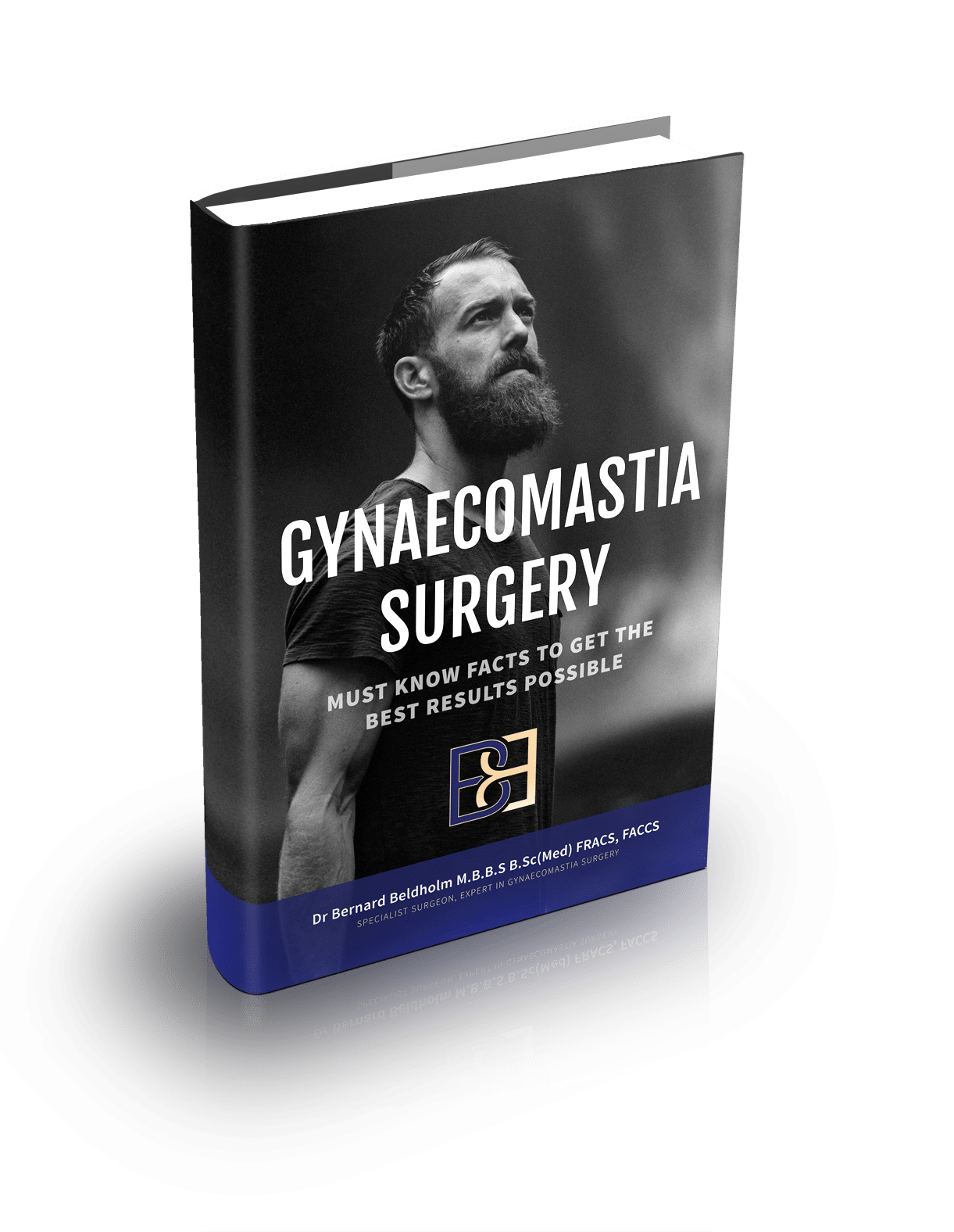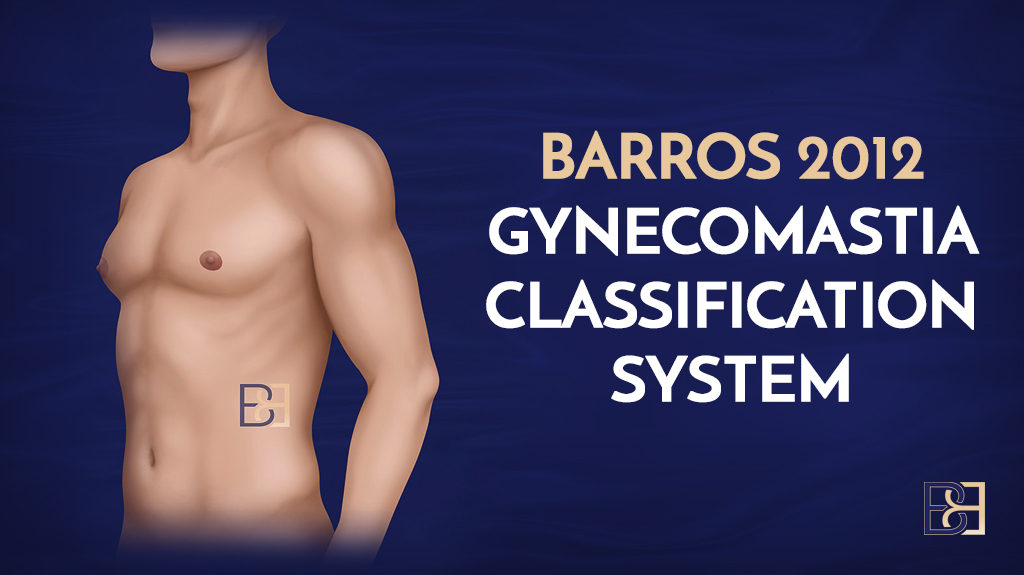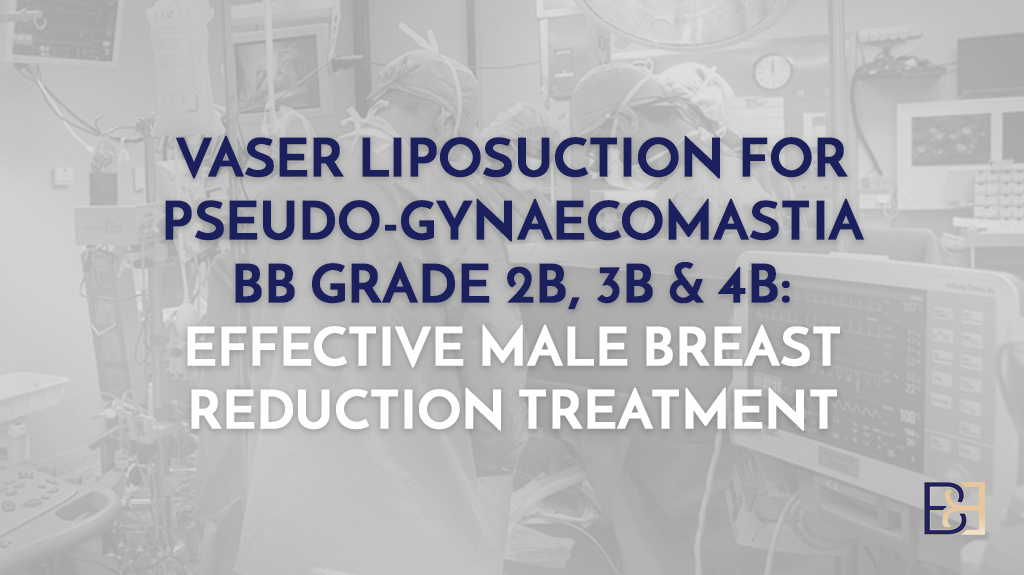More than a physical condition or aesthetic concerns, men suffering with gynaecomastia are also burdened with psychological issues and emotional distress, which can be just as, if not more, debilitating.
Developed after a decade and half of experience treating men with gynaecomastia, my goal when creating this new classification system was to help providers and patients with holistic, sustainable, and innovative tools that take modern approaches, current techniques, and the health and wellness of the whole man into consideration.
I’d like to thank my many patients, colleagues, and the many predecessors who’ve come before me for paving the way throughout this journey.
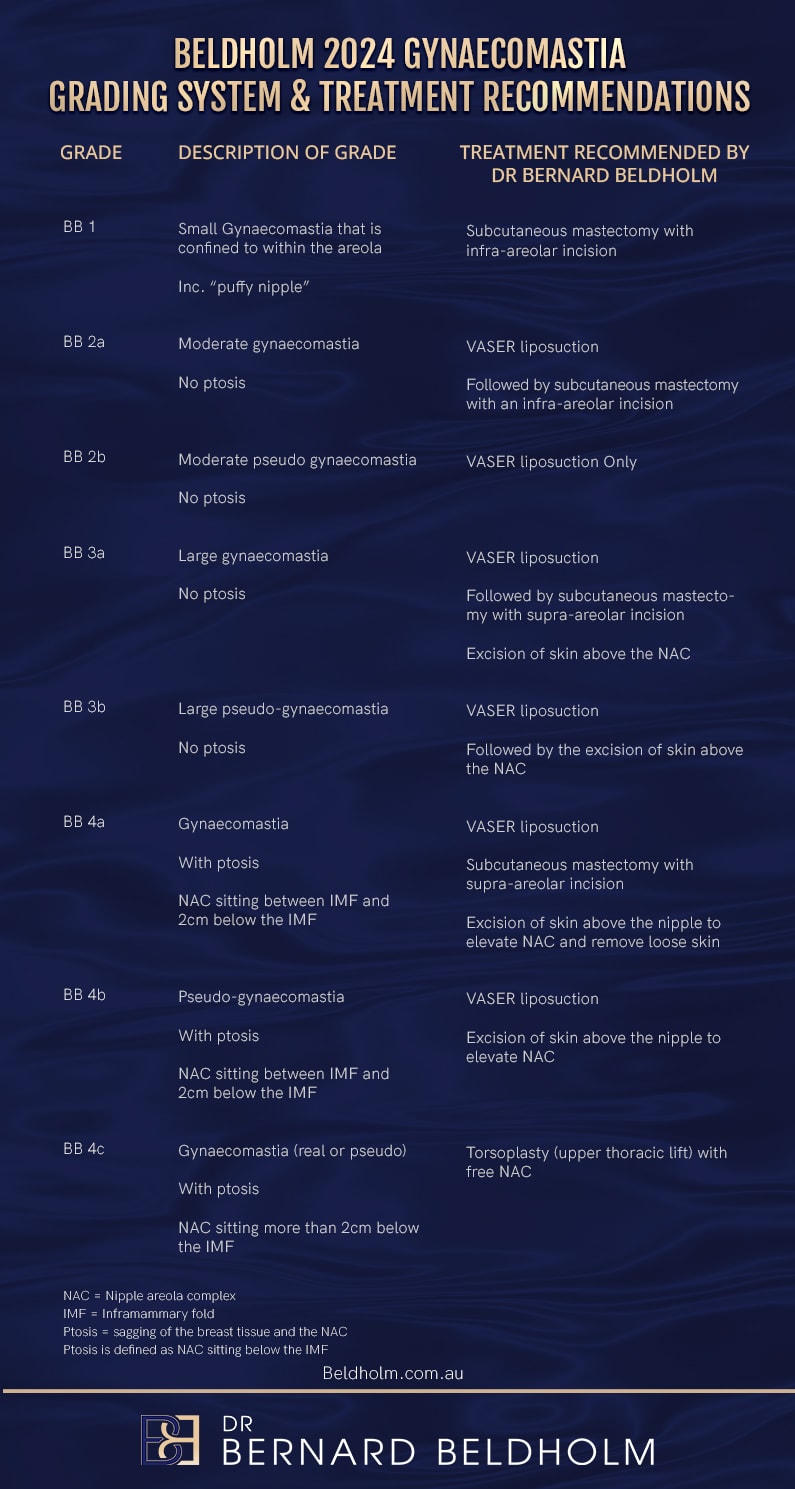
Book your appointment online now
Gynaecomastia Overview
Frequently used as an umbrella term when referring to the enlargement of the male breast, some forms of gynaecomastia fall under the category of true or real gynaecomastia, while others are considered pseudo-gynaecomastia.
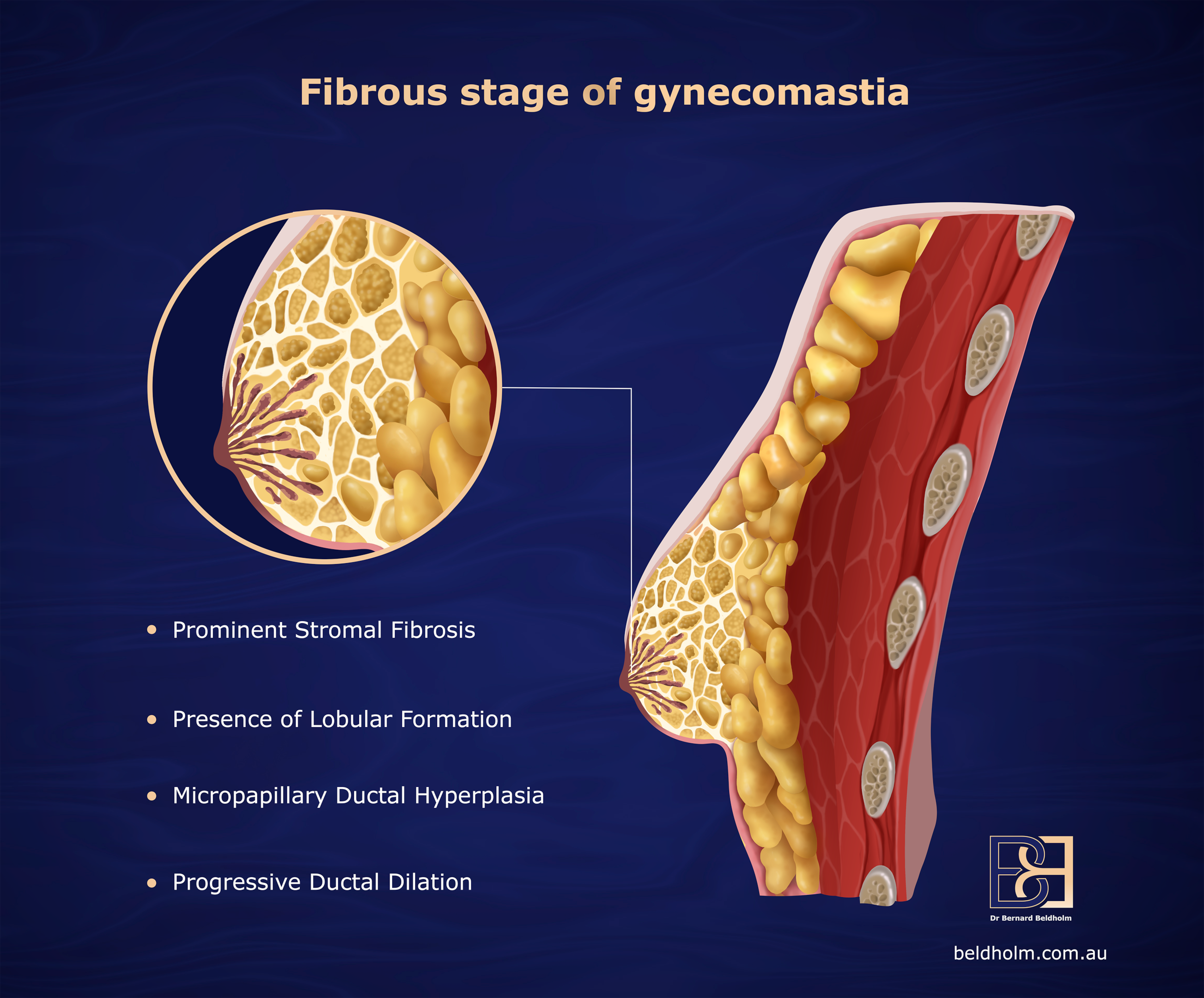
From a surgical point of view, I look at all forms of gynaecomastia as a female-looking chest in a male, regardless of the cause or category. As such, I feel that it doesn’t matter if the condition is real gynaecomastia or pseudo-gynaecomastia as the impact of the condition and the way that the chest looks can be very similar. It therefore makes no sense to limit the grading system to the presence of breast glands.
Real Gynaecomastia vs. Pseudo-Gynaecomastia
Before I continue, it’s important to understand the difference between real gynaecomastia and pseudo-gynaecomastia. The key difference between the two variations of the condition centres around the type of tissue causing the enlargement of the male breast.
Real Gynaecomastia
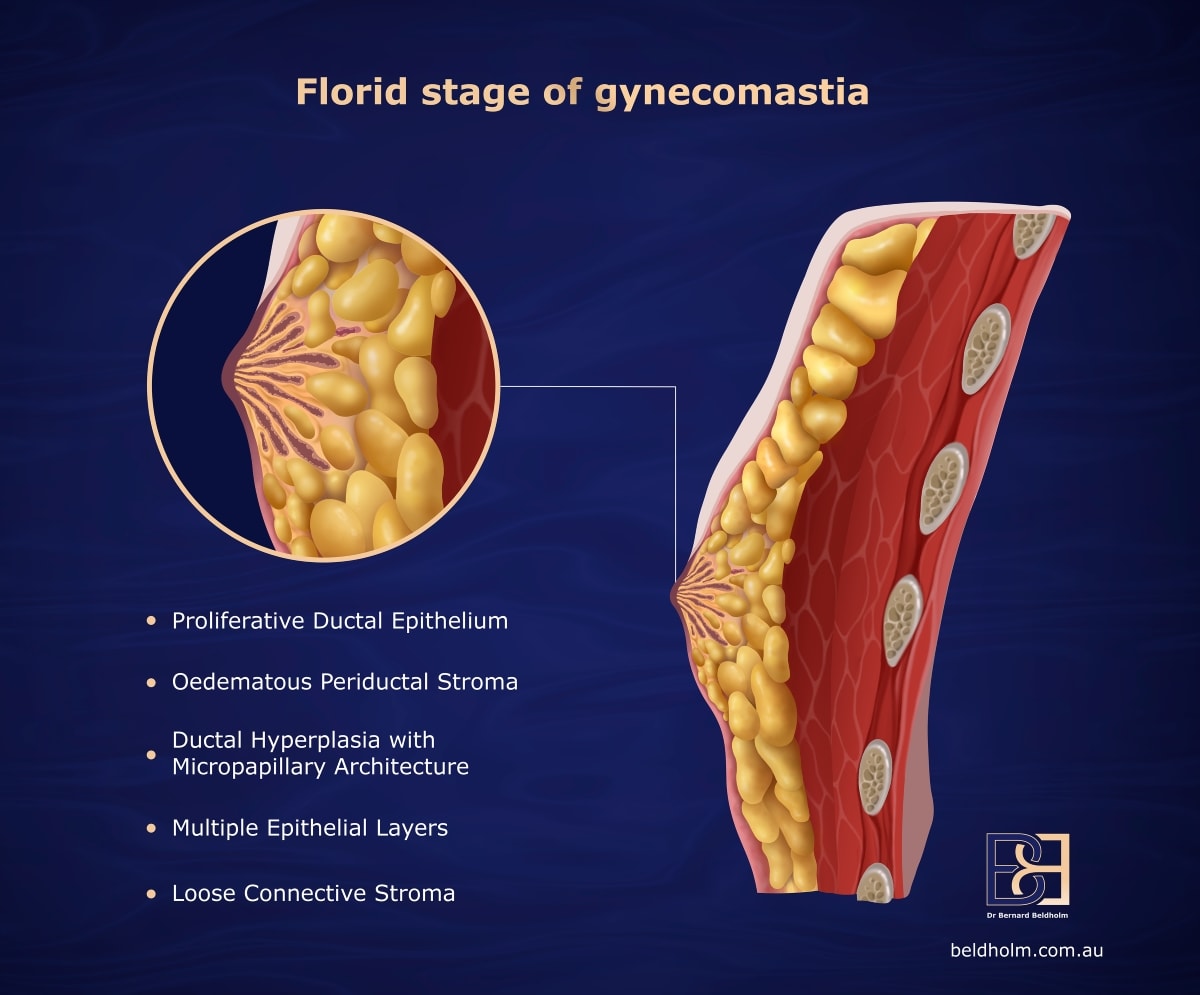
Real gynaecomastia, a condition characterised by the enlargement of breast tissue in males, is typically caused by an imbalance between the hormones oestrogen (which promotes breast tissue growth) and testosterone (which inhibits it). This condition can affect one or both breasts, sometimes unevenly.
Characteristics of Real Gynaecomastia
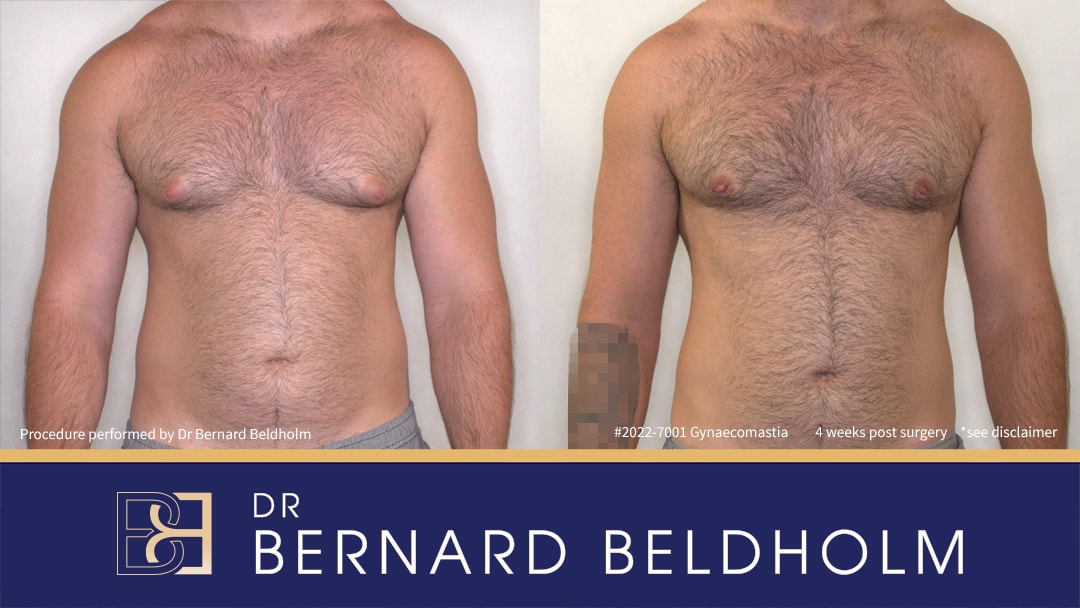
Tattoo blurred (Right arm in after photo) for privacy.
Disclaimer: Operation performed by Dr Bernard Beldholm. Adult content, surgery has risks; individual results vary, seek 2nd opinion. Please see the full disclaimer.
- Firm or rubbery breast tissue, typically beneath the nipple.
- Often symmetrical, but can occur in one or both breasts.
- It can be tender or painful.
Pseudo-Gynaecomastia
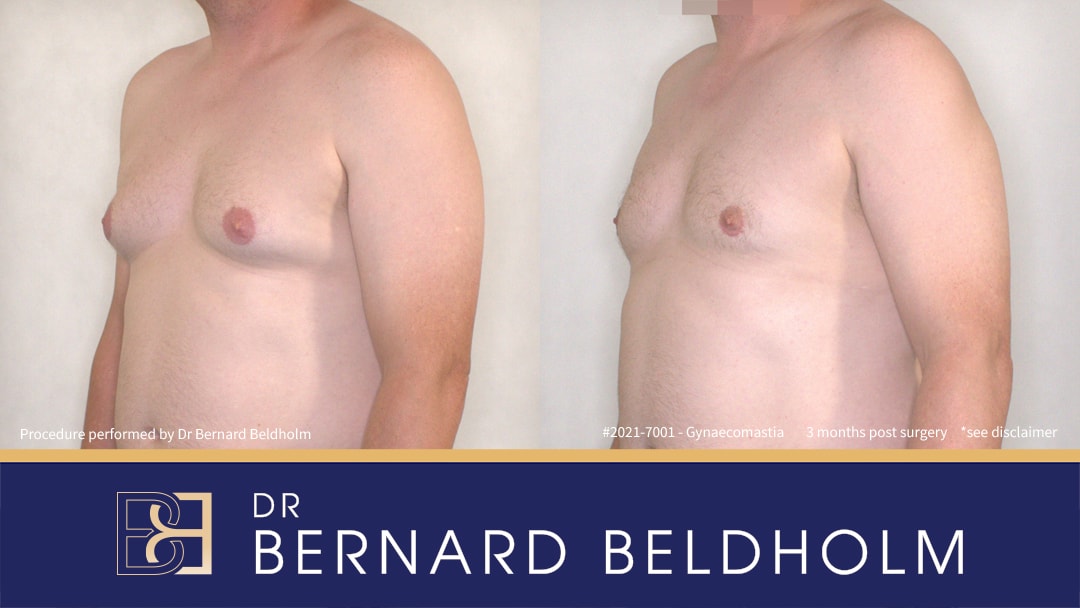
Disclaimer: Operation performed by Dr Bernard Beldholm. Adult content, surgery has risks; individual results vary, seek 2nd opinion. Please see the full disclaimer.
Caused by an accumulation of fat in the chest area, often due to obesity, this form of the condition is often triggered by weight issues rather than hormonal imbalances.
Characteristics of Pseudo-Gynaecomastia
- Soft, fatty tissue that feels different from glandular tissue
- Often proportional to other areas of the body with excess fat
- Typically not painful or tender.
How to Differentiate Between Real Gynaecomastia and Pseudo-gynaecomastia
Physical Examination: Real gynaecomastia feels firmer, while pseudo-gynaecomastia is softer.
Medical Imaging: Ultrasound, mammography, or other diagnostic tests can distinguish glandular tissue (real) from fat tissue (pseudo) to confirm the condition and recommend appropriate treatment
Bloods: Hormonal evaluations through blood tests can identify imbalances. However, in the majority of patients with gynaecomastia, the results will be normal.
Why I Created the 2024 Beldholm Gynaecomastia Staging System

During my 15 years of practice treating gynaecomastia, I have seen many post-weight loss patients with a significant amount of loose skin in the chest area that may look like pendulous female breasts. However, they may not contain “breast gland tissue,” per se. The impact on the man, both physically and psychologically, however, is generally the same. I have therefore incorporated both Real Gynaecomastia and Pseudo-gynaecomastia into my staging system.
Other issues I considered when creating my grading system include scars and expectations. With smaller-grade gynaecomastia, the scars are placed in the areola. With higher grades, however, it becomes necessary to remove loose skin from the chest wall which does longer leave scars. In such cases, the male must weigh whether scars are acceptable in exchange for a flatter, more masculine chest. It has been my experience when treating many post-weight loss patients, the preference is to live with the scars.
Psychological Impacts of Gynaecomastia
Beyond physical discomfort, gynaecomastia can often lead to significant embarrassment and emotional distress. For many, the condition can cause social anxiety, interfere with daily interactions, and relationship difficulties, making prompt treatment essential (ref 23).
One study concluded that “[i]diopathic adolescent gynecomastia is a psychological threat to sexual identity. Patients that present with [this condition] are more likely to suffer an adjustment disorder subsequent to this anatomic stressor.” (ref 23)
In some cases, such as that in many adolescent boys, the physical symptoms may resolve on their own. Persistent cases, however, may require medical intervention. In my practice, treatment is commonly pursued when the condition is severe and persistent or causes significant emotional or psychological issues. Understanding the different grades of gynaecomastia, from mild (BB Grade 1) to severe (BB Grade 4C), helps in determining the appropriate treatment approach, whether it be surgical or non-surgical.
Read more: Dr. Bernard Beldholm’s Comprehensive Summary of Gynaecomastia Surgery Grading Systems
Beldholm 2024 Gynaecomastia Classification System
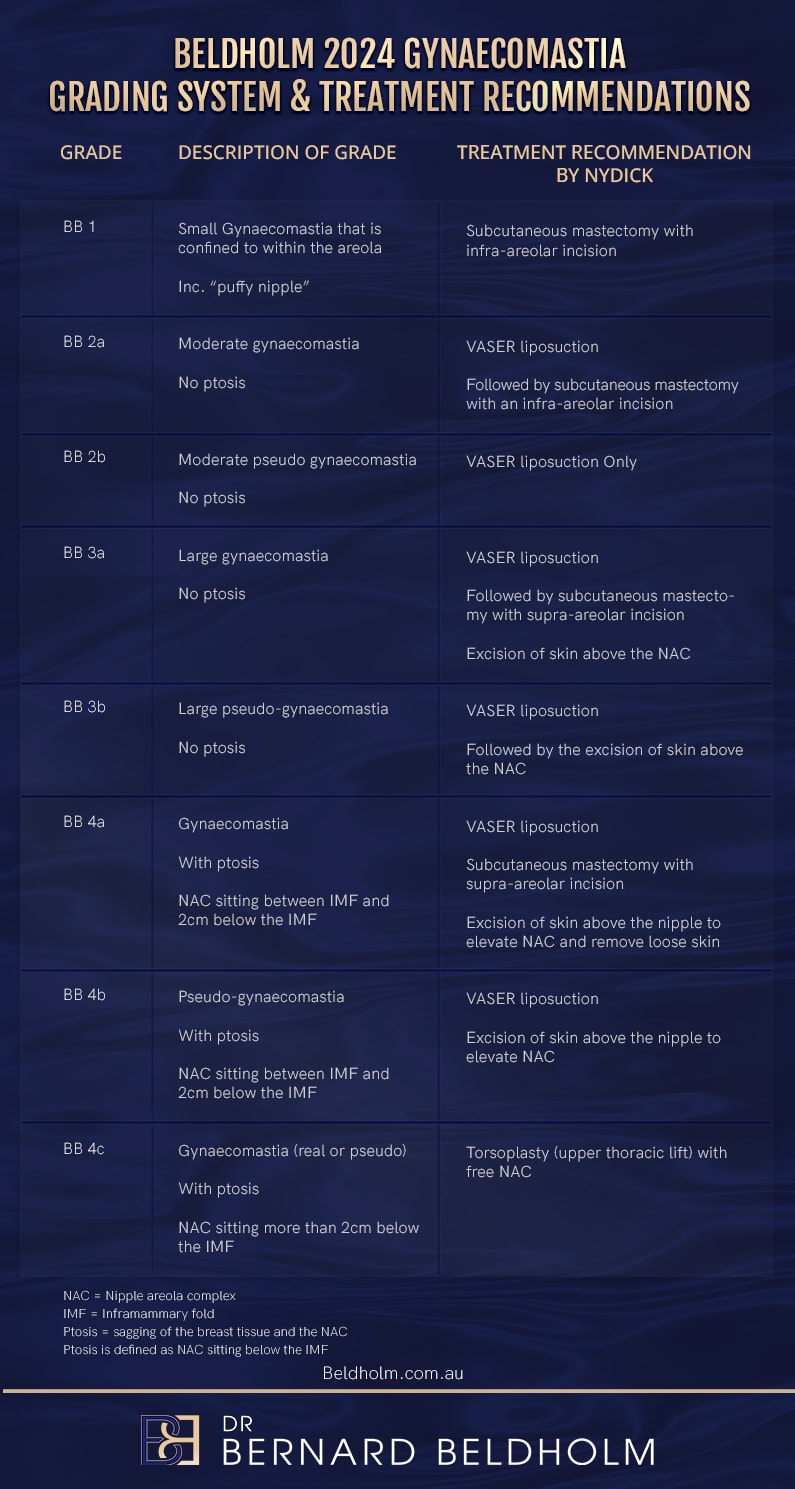
BB Grade 1 Classification
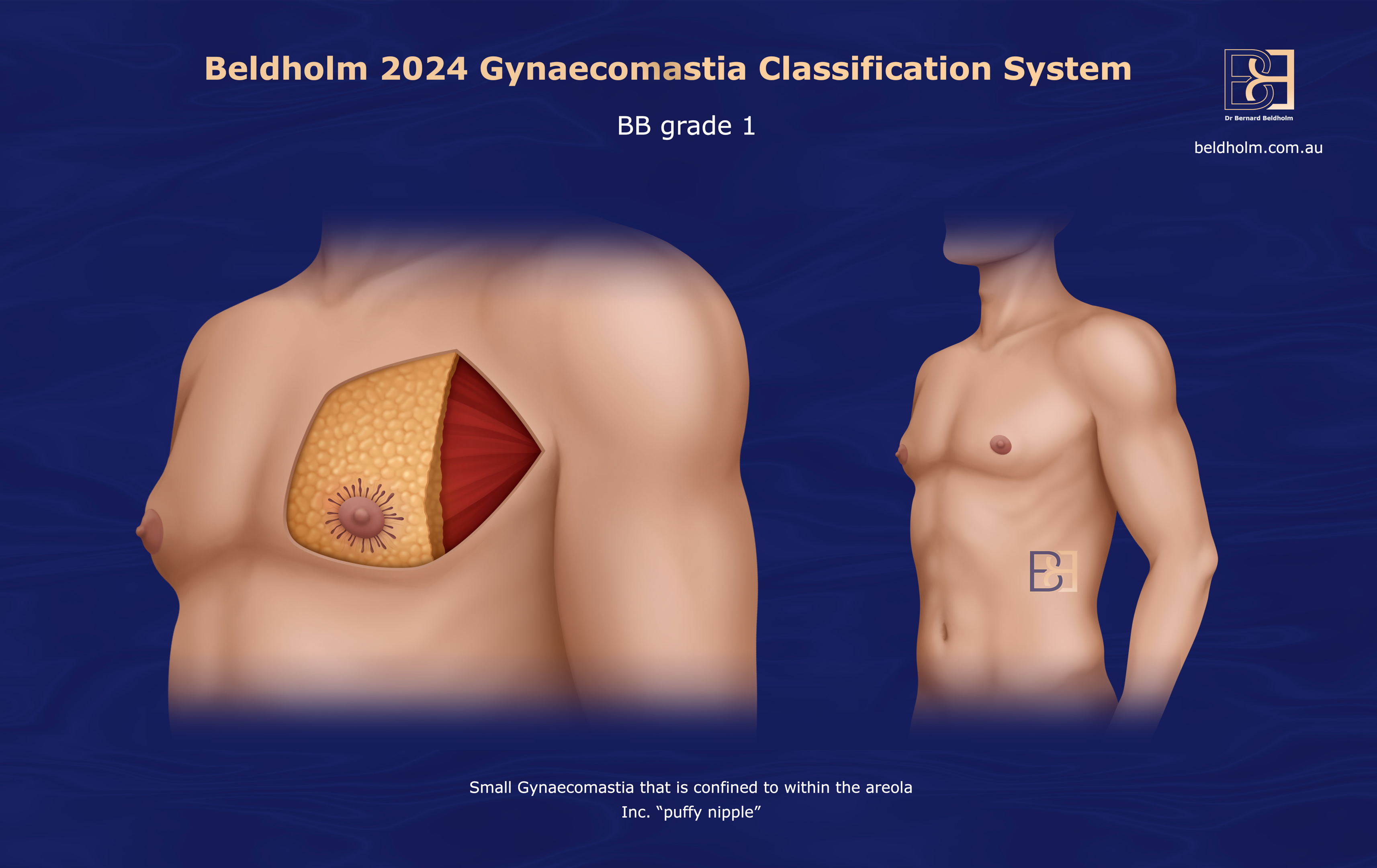
Presentation:
- Small Real Gynaecomastia that is confined within the areola
- Usually hard under the NAC
- Easily felt on palpation
- Usually bilateral
Treatment: Subcutaneous Mastectomy with Infra-Areolar Incision
BB Grade 2a Classification
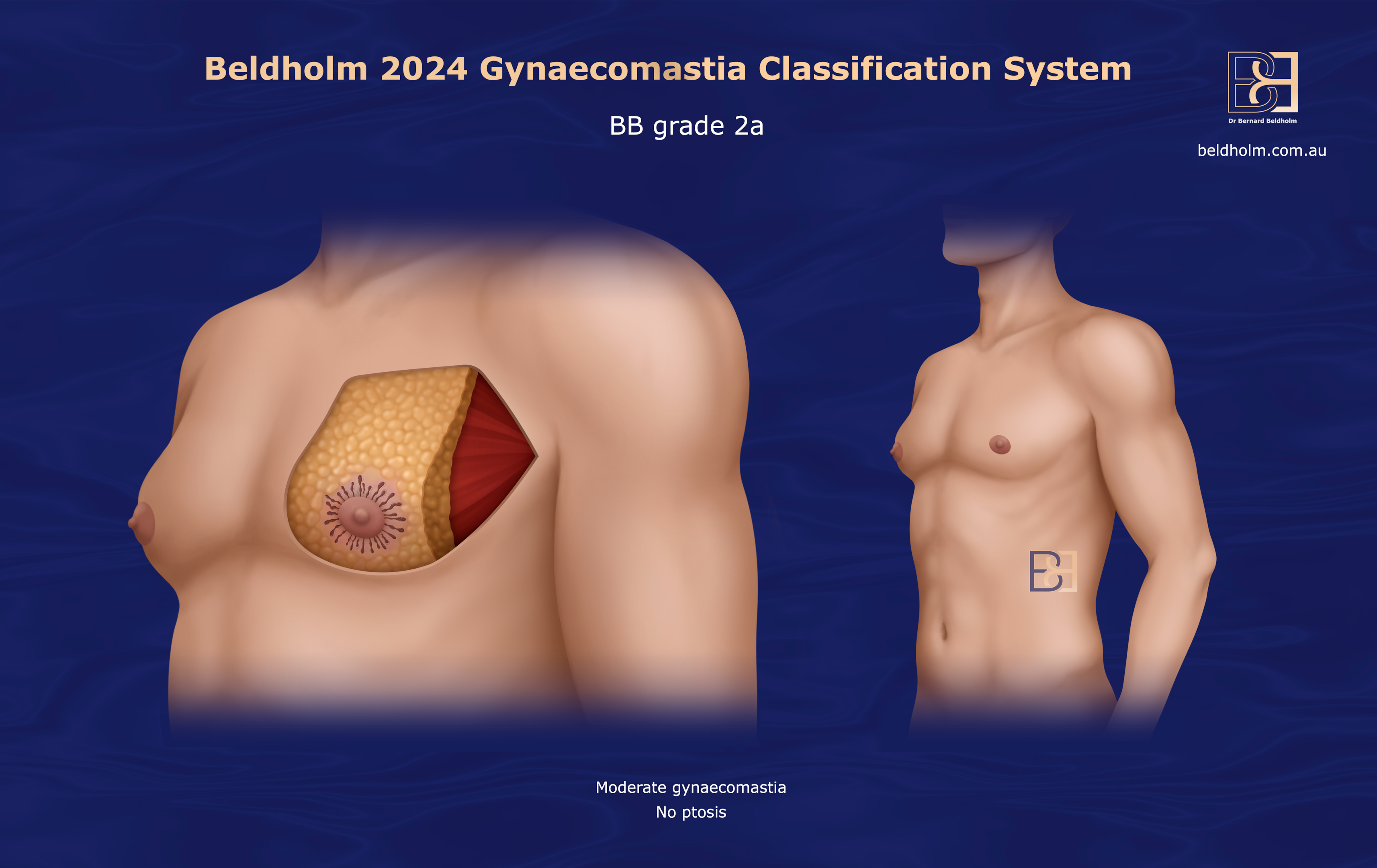
Presentation:
- Moderate Real gynaecomastia with No Ptosis
- Palpable beyond the NAC.
- Usually has excess lateral chest wall fat.
Treatment: Subcutaneous Mastectomy with Infra-Areolar Incision with Suction-assisted lipectomy
BB Grade 2b Classification
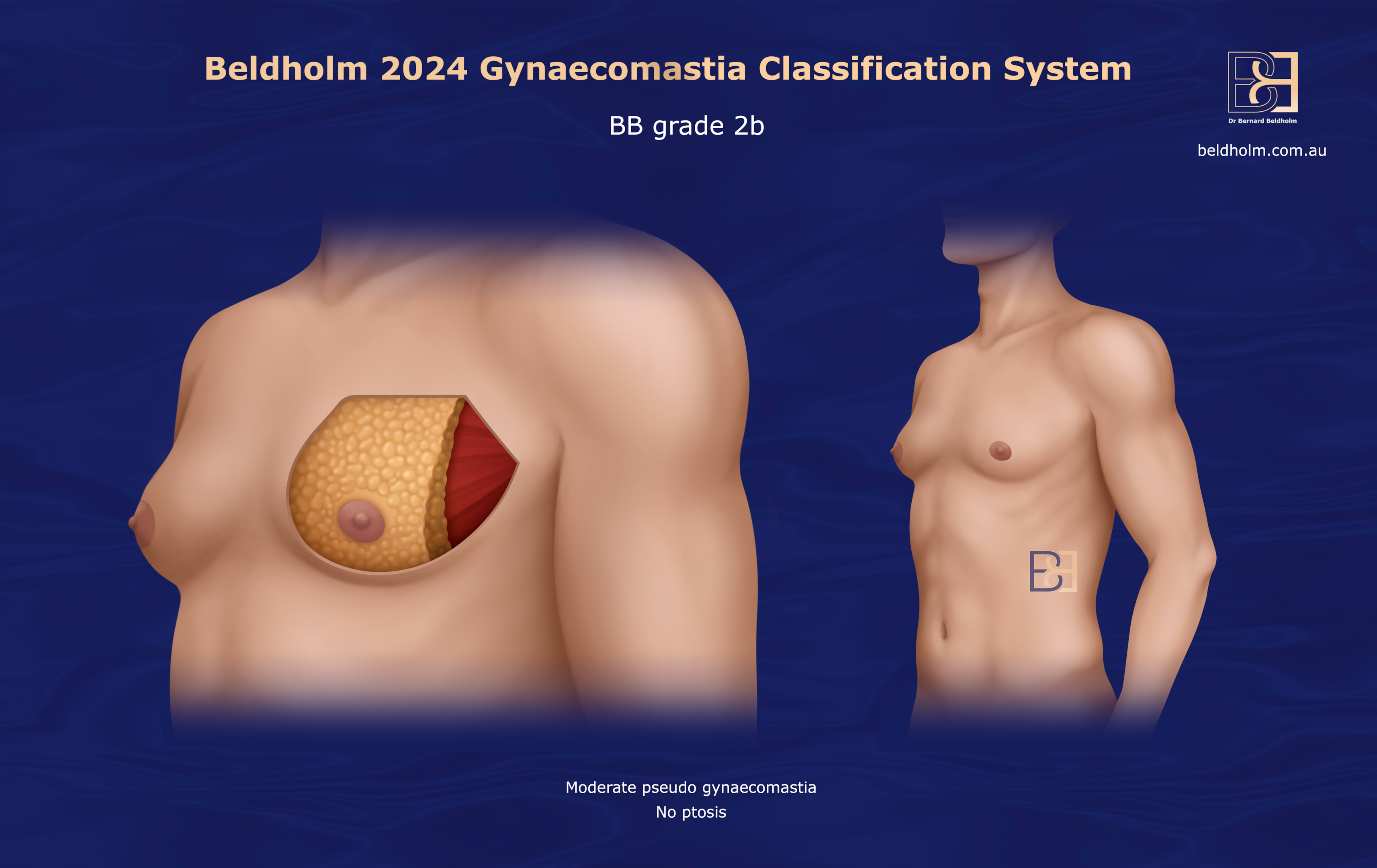
Presentation:
- Moderate pseudo gynaecomastia with no ptosis
- No breast gland present
- Excess lateral chest wall fat.
Treatment: VASER Liposuction (Suction-assisted lipectomy)
BB Grade 3a Classification
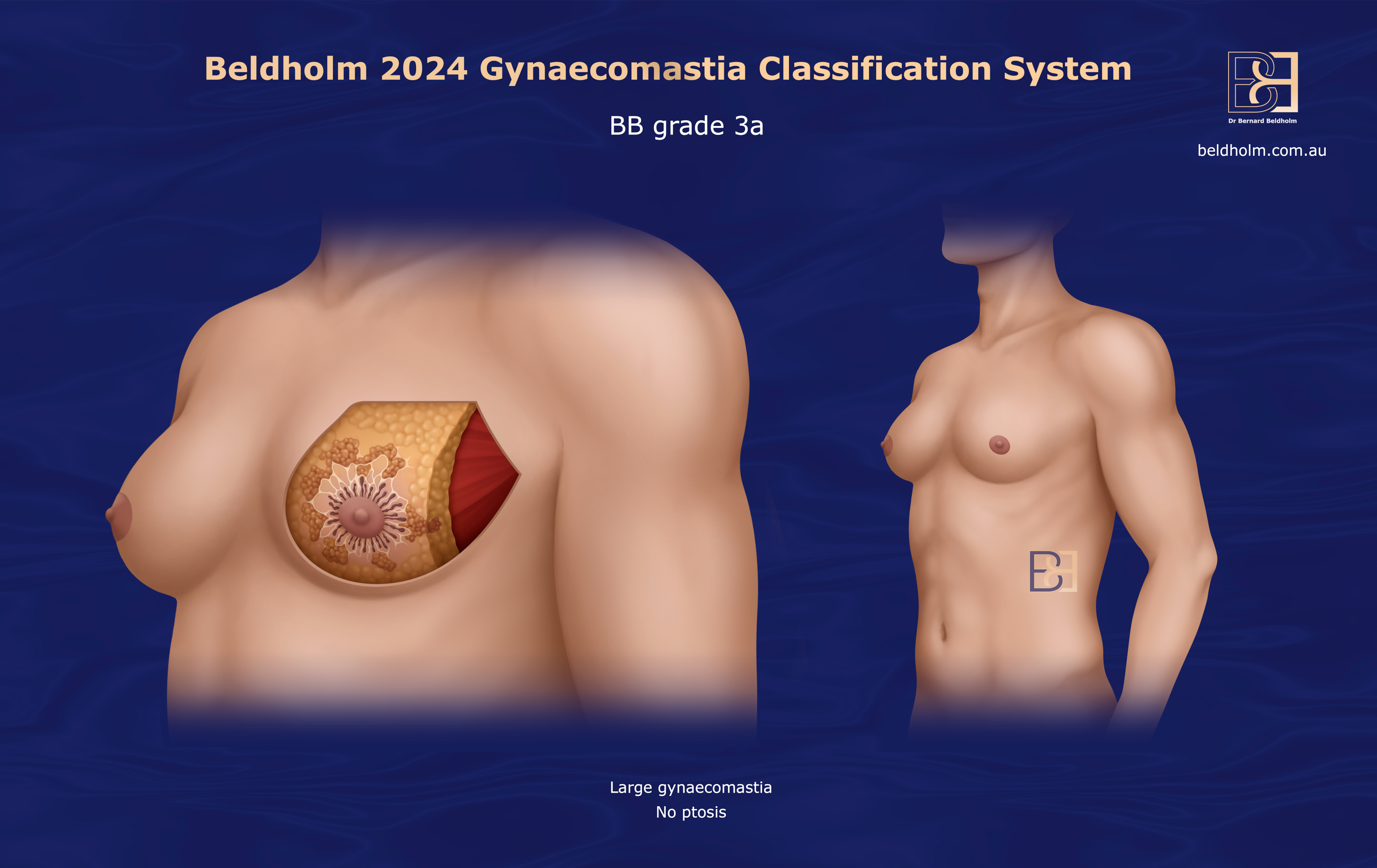
Presentation: Large gynaecomastia with no ptosis
- If the diameter of the gynaecomastia measures 15 cm or more, it is typically classified as large. However, this classification should also take into account various patient-specific factors, such as skin elasticity, tissue composition, and overall body shape, which can influence the appropriate treatment approach.
Treatment:
- Subcutaneous mastectomy with supra-areolar incision with Suction-assisted lipectomy
- Excision of skin above the nipple to elevate NAC
- Remove loose skin
* Grade 3 is borderline and the final result will depend on how well the skin retracts. It is important to talk to the patient about the potential need for revision surgery to excise loose skin further. This should be done 6 months or more after the original operation.
BB Grade 3b Classification
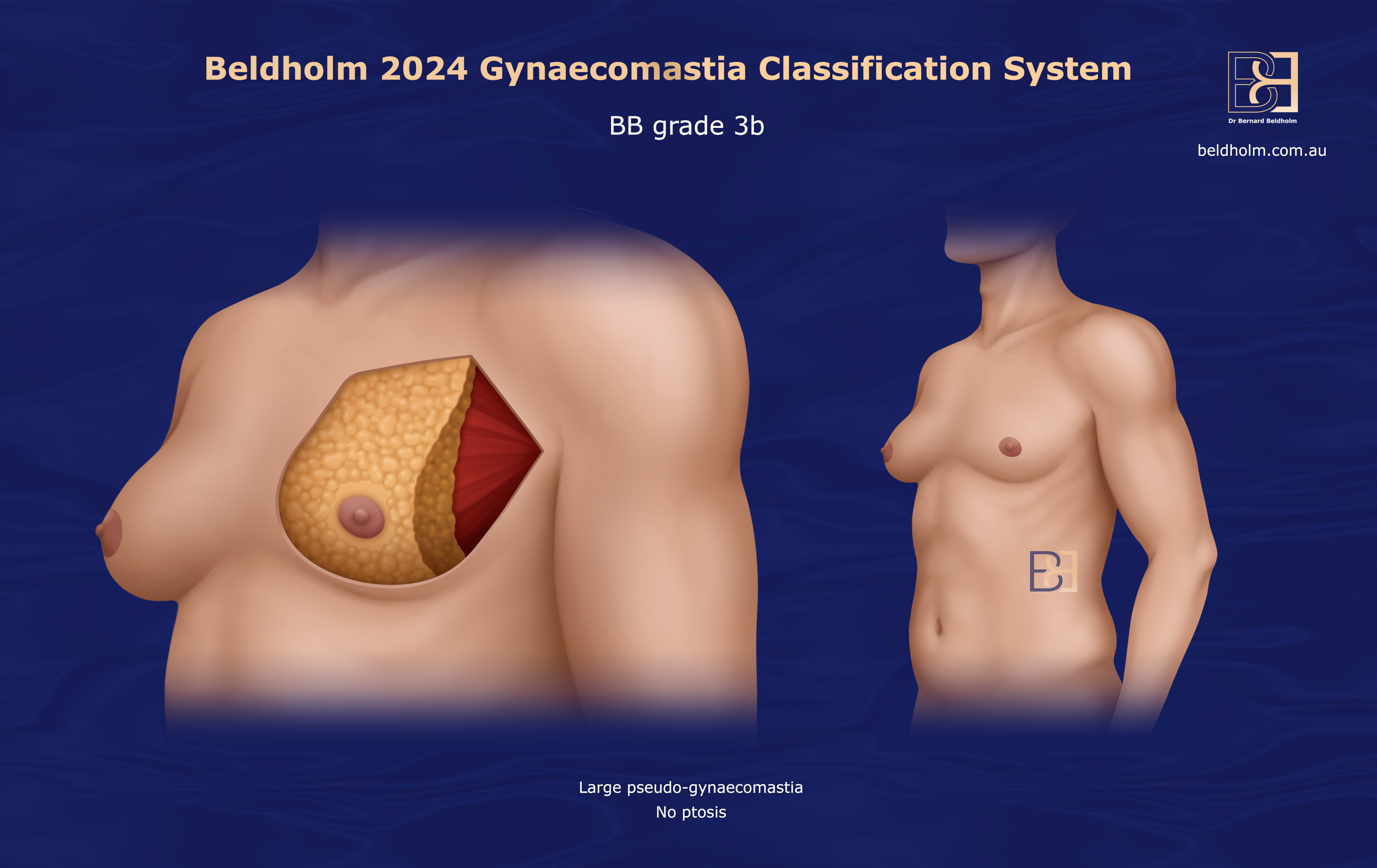
Presentation:
- Large pseudo-gynaecomastia
- If the diameter of the pseudo-gynaecomastia measures 15 cm or more, it is typically classified as large. However, this classification should also take into account various patient-specific factors, such as skin elasticity, tissue composition, and overall body shape, which can influence the appropriate treatment approach.
- No ptosis
Treatment:
VASER Suction-assisted lipectomy and excision of skin above the nipple to elevate NAC and remove loose skin
* Grade 3 is borderline and the final result will depend on how well the skin retracts. It is important to talk to the patient about potential need for revision surgery to excise loose skin further. This should be done 6 months or more after the original operation.
BB Grade 4a Classification
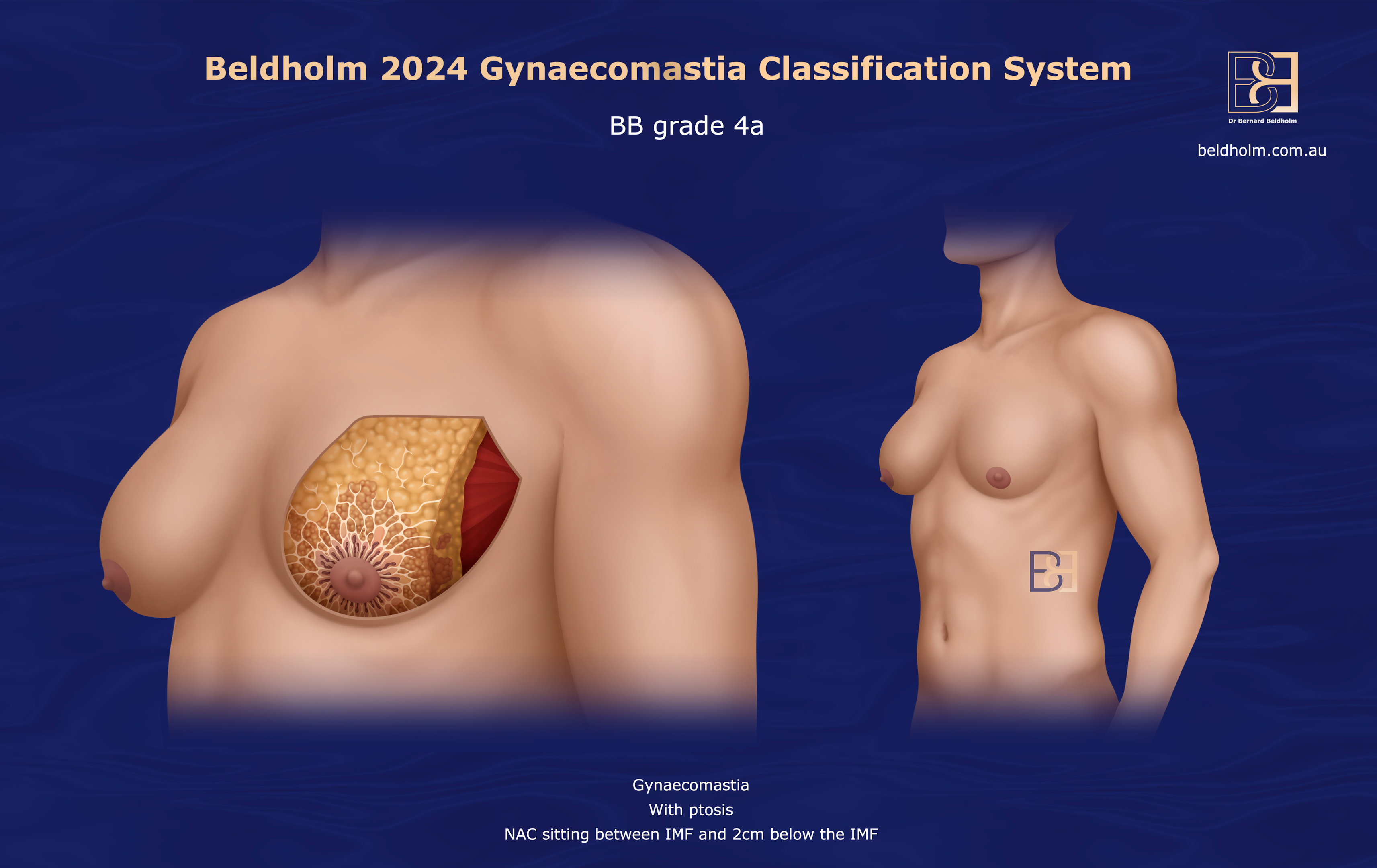
Presentation:
- Large Gynaecomastia
- Ptosis
- NAC sitting 0-2 cm below the IMF
Treatment:
- Suction-assisted lipectomy
- Subcutaneous mastectomy with supra-areolar incision
- Excision of skin above the nipple to elevate NAC and remove loose skin
* Grade 4a final result will depend on how well the skin retracts. It is important to talk to the patient about potential need for revision surgery to excise loose skin further. This should be done 6 months or more after the original operation.
BB Grade 4b Classification
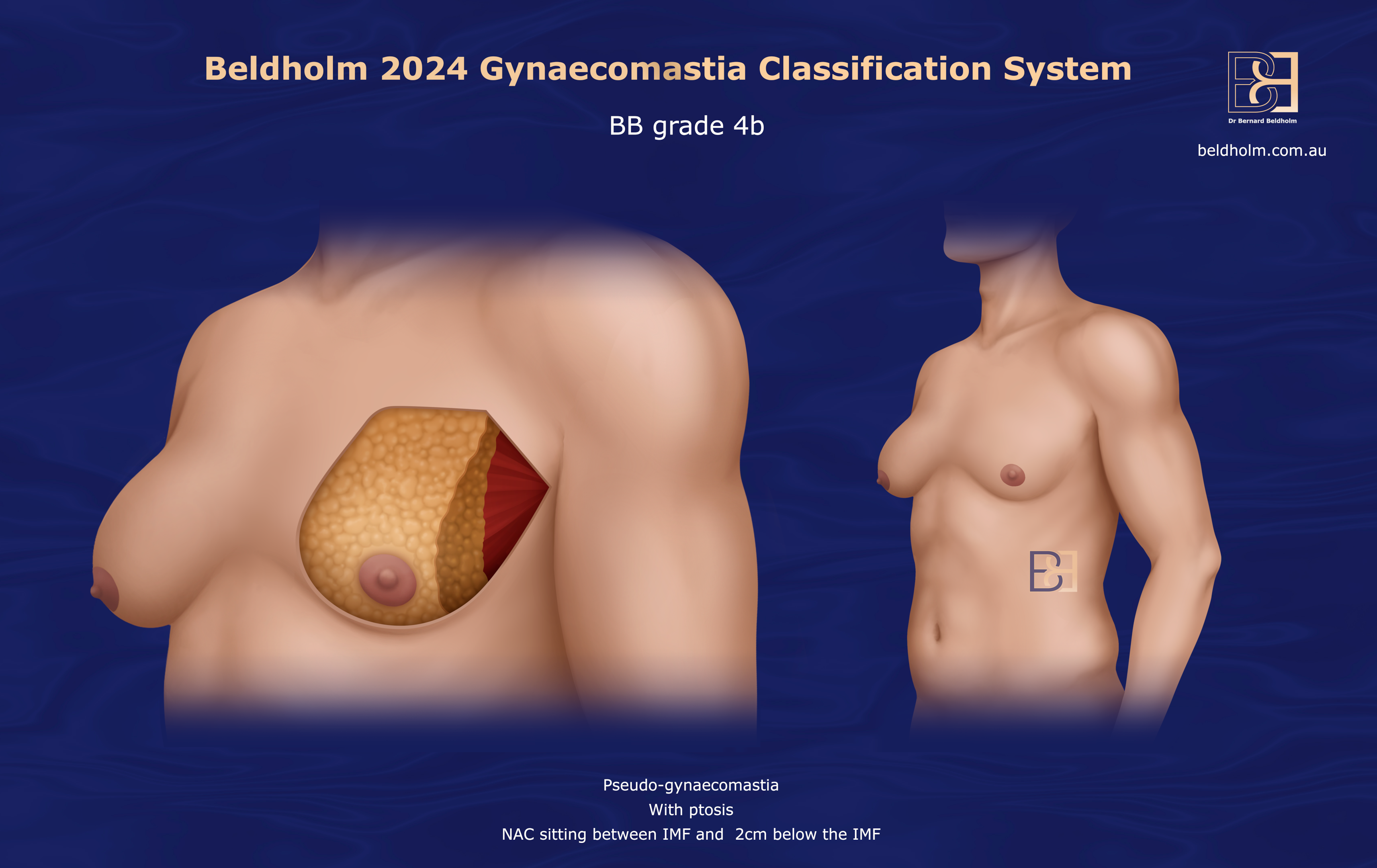
Presentation:
- large Pseudo-gynaecomastia
- Ptosis
- NAC sitting more than 2 cm below the IM
Treatment:
- Suction-assisted lipectomy
- Excision of skin above the nipple to elevate NAC
* Grade 4b final result will depend on how well the skin retracts. It is important to talk to the patient about potential need for revision surgery to excise loose skin further. This should be done 6 months or more after the original operation.
BB Grade 4c Classification
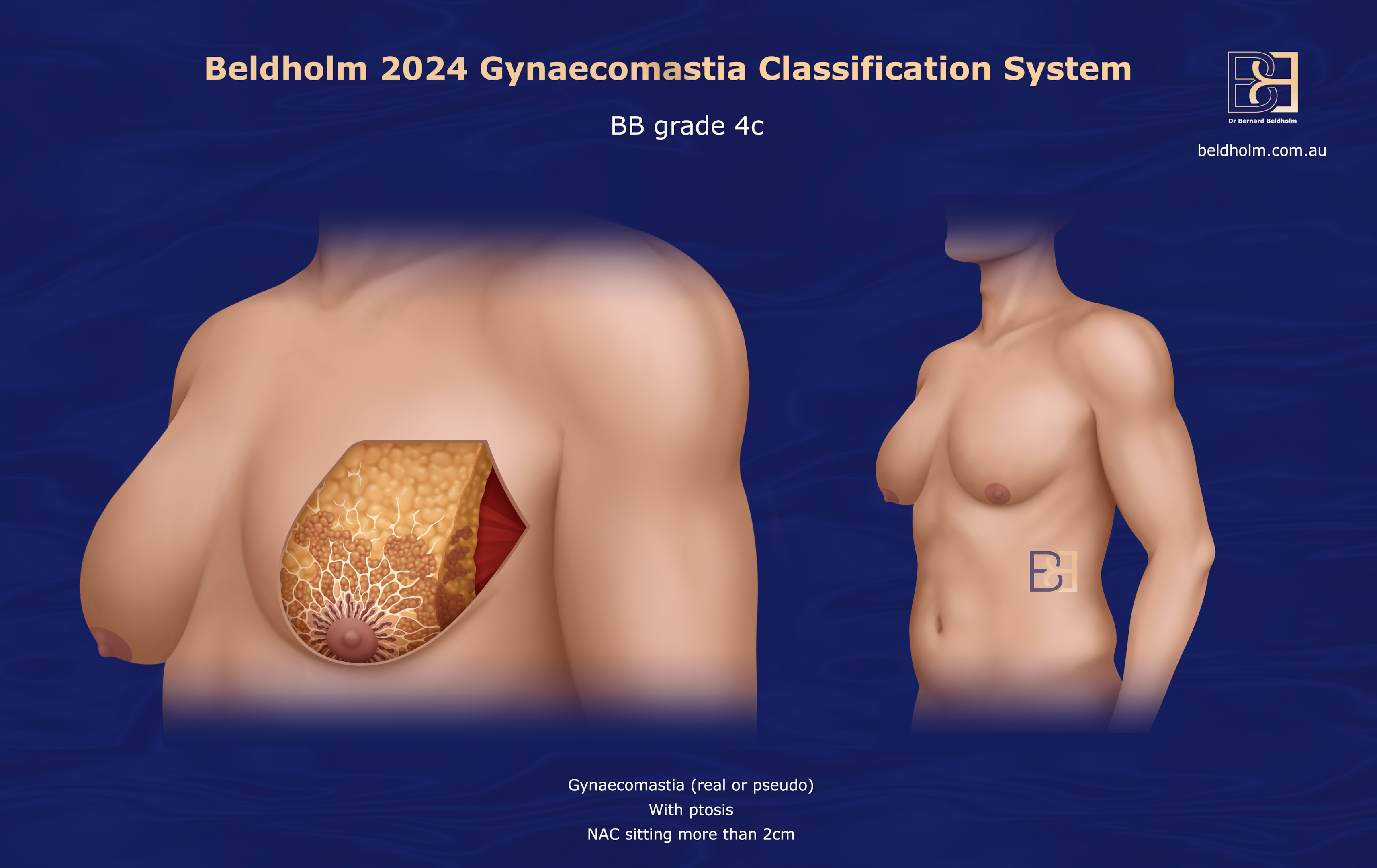
Presentation:
- Gynaecomastia (real or pseudo)
- Ptosis
- Usually significant amount of loose skin
- NAC sitting more than 2 cm below the IMF
Treatment:
- Torsoplasty (Upper Thoracic Lift) with free NAC (Nipple Areolar Grafts):
- In my opinion, pedicle techniques do not offer sufficient chest reshaping. They often leave a rounded, bulky appearance and have a higher risk of complications, including nipple necrosis.”
Earlier Grading Systems of Gynaecomastia
Most of the earlier grading systems mention flattening of the inframammary fold, though this depends on the patient. A bodybuilder, for example, will have a very defined inframammary fold.
Read more: Bodybuilder’s Guide to Managing Gynaecomastia
In addition, many early grading systems mention that NAC at the level of the IMF is abnormal. However, NAC in men with a lean physique, such as bodybuilders, sits on the edge of the pectoralis major muscle.
Surgical Approach
- Using a patient-centric approach, I prefer to treat each of my patients on a one-on-one basis.
- I define the edge of the pectoralis major muscle to create a masculine contour. This is especially important for muscular patients.
- I attempt to minimise scars as much as possible.
- I place the focus on the whole chest area, not just the gynaecomastia, including:
- Lateral chest
- Upper abdomen
- Thoracic region
- Nipple-areola complex
- Removal of redundant skin
- Symmetrisation
* Note: If the patient is overweight or less defined, the goal is to create a flat chest proportionate to the rest of the body.
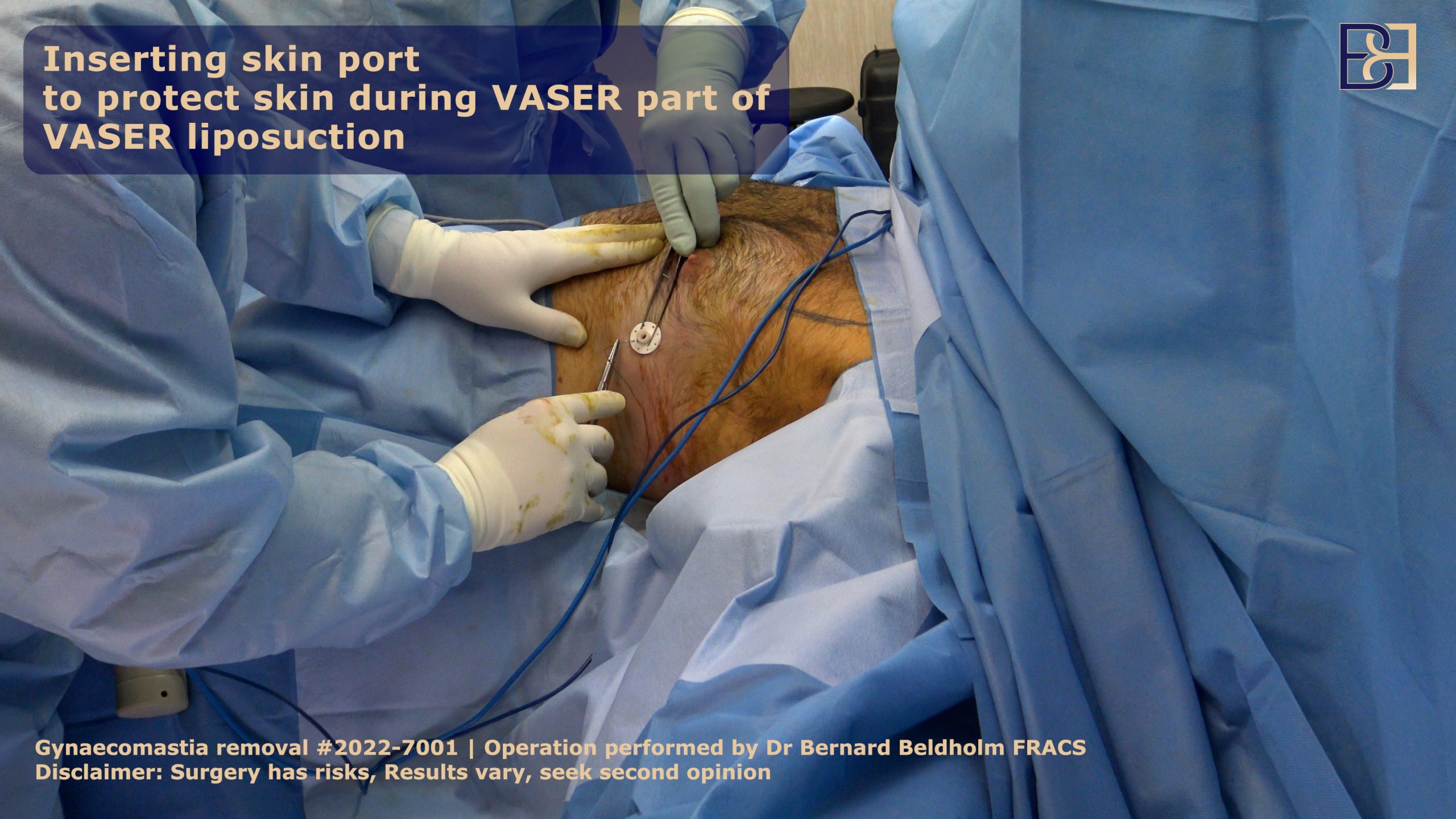
Disclaimer: Operation performed by Dr Bernard Beldholm. Adult content, surgery has risks; individual results vary, seek 2nd opinion. Please see the full disclaimer.
Surgical Treatment Options
There are now more advanced surgical techniques available for treating enlarged breasts in males, each treating different aspects and severity of the condition. The most common procedures include:
Subcutaneous Mastectomy with Infra-areolar Incision
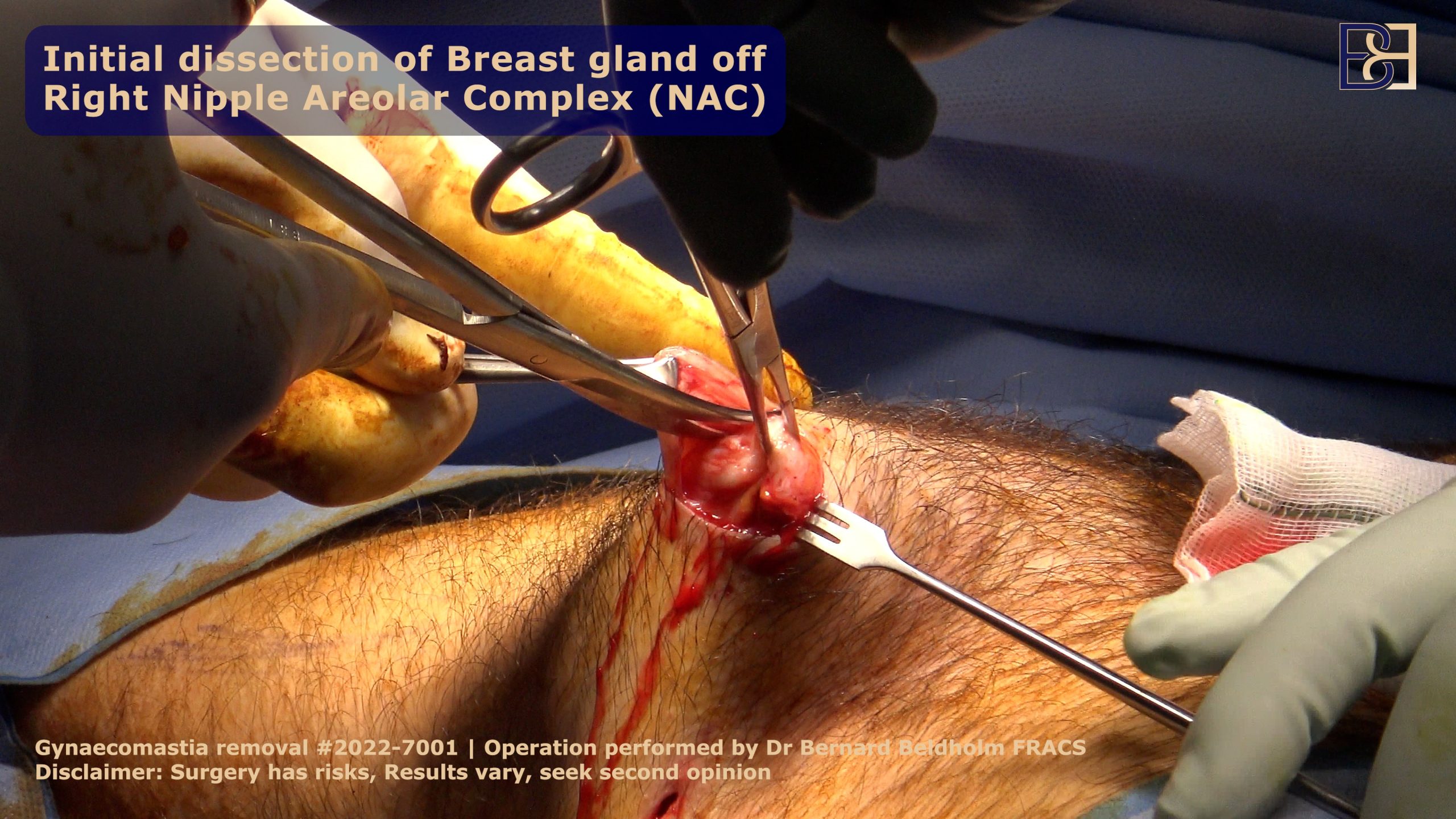
To treat small Gynaecomastia that is confined within the areola, subcutaneous mastectomy for gynaecomastia is a surgical procedure performed to remove glandular breast tissue from a male with enlarged breasts.
Vaser Liposuction
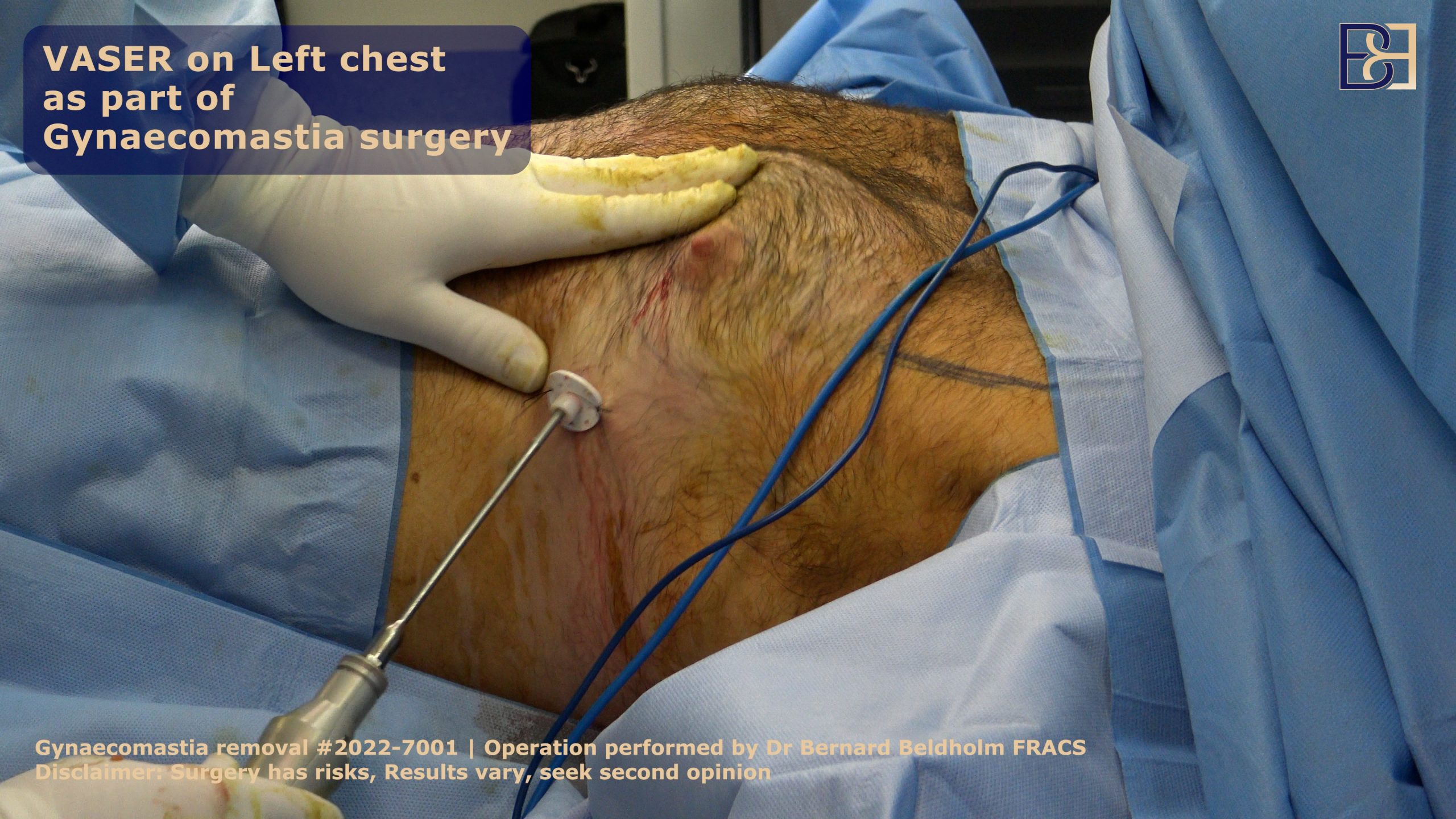
Utilising ultrasound technology to break down fat cells, Suction-assisted lipectomy is a more targeted than traditional liposuction, playing a crucial role in the current treatment of gynaecomastia, with patients benefiting from reduced bruising and shorter recovery times.
In fact, in cases of moderate pseudo-gynaecomastia without ptosis, Suction-assisted lipectomy is the recommended course of treatment.
Combined Subcutaneous Mastectomy with Infra-areolar Incision with VASER Suction-assisted lipectomy
For patients with large or moderate gynaecomastia without ptosis, VASER Suction-assisted lipectomy followed by subcutaneous mastectomy with infra-areolar incision would be the appropriate treatment. A modern dedicated technique that utilises ultrasound technology to break down fat cells, making them easier to remove, VASER Suction-assisted lipectomy is particularly effective for pseudo-gynaecomastia, where the enlargement is primarily due to excess fatty tissue rather than glandular tissue.
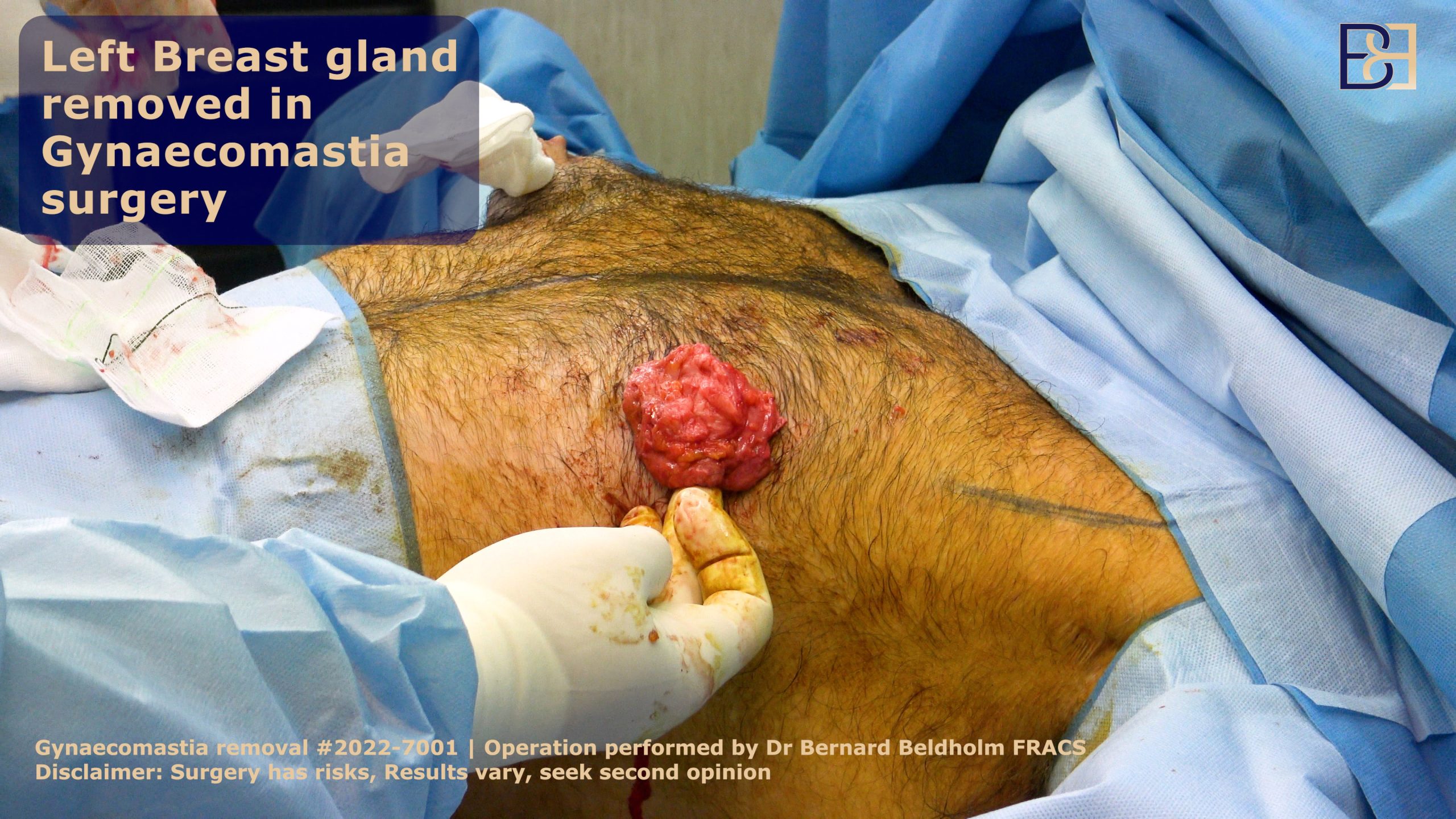
Read more: Combining subcutaneous mastectomy with liposuction to treat gynaecomastia
When patients are presented with excess glandular and fatty tissue (i.e., those experiencing massive weight loss), a combination of gland excision and VASER Suction-assisted lipectomy may provide the best results. Initially performed to remove the surrounding fat, Suction-assisted lipectomy is commonly followed by the removal of excess breast gland tissue through a small incision in the areola.
Minor Skin Tightening
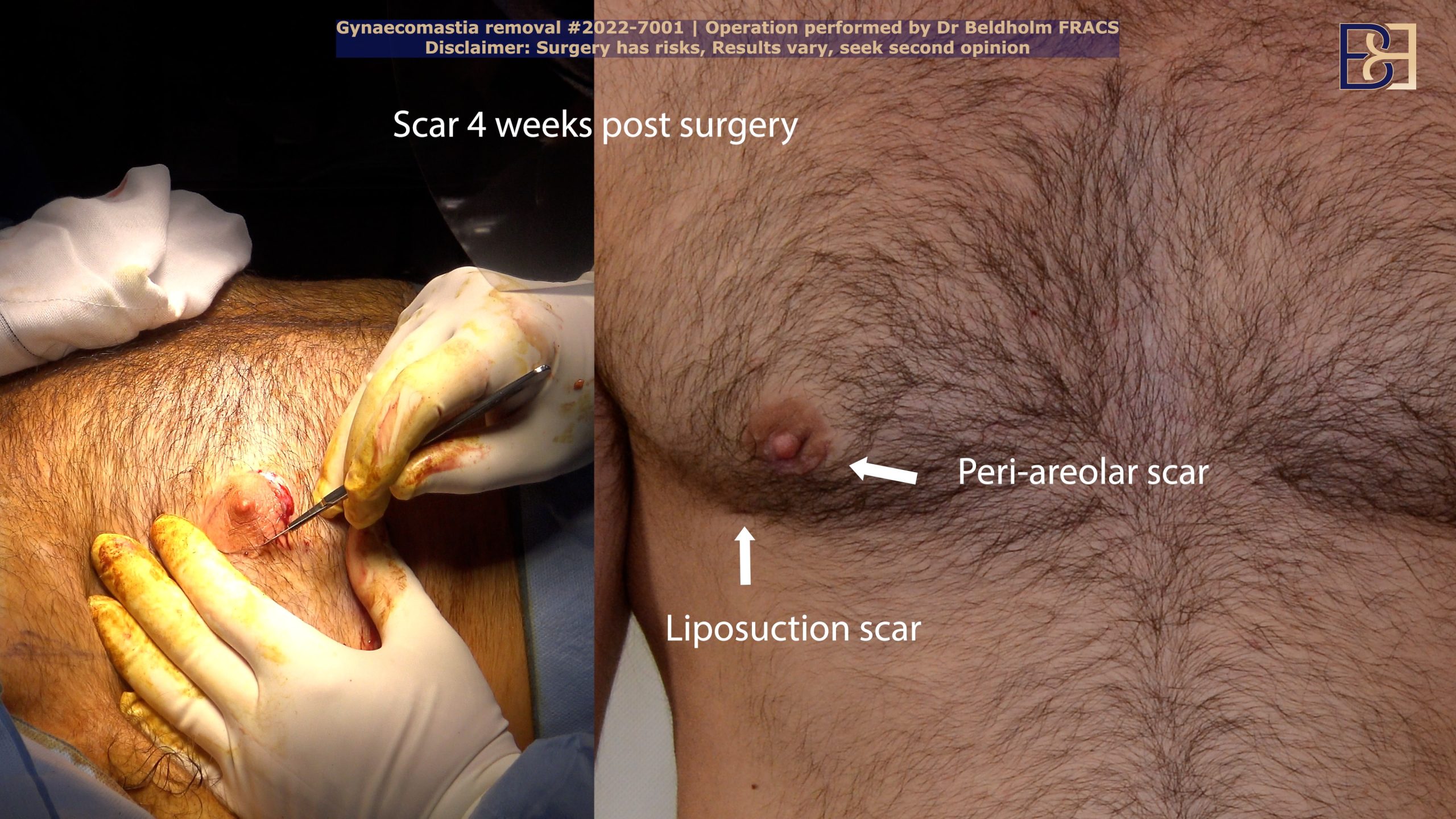
A circular excision of skin, V and U lifts, and other skin tightening procedures can be used to treat male breast enlargement in some cases.
Subcutaneous Mastectomy with Supra-areolar Incision with Suction-assisted lipectomy
For patients with gynaecomastia with ptosis and NAC sitting 0-2 cm below the IMF, Suction-assisted lipectomy with subcutaneous mastectomy with supra-areolar incision with excision of skin above the nipple to elevate NAC and remove loose skin.
Torsoplasty with Nipple Areolar Grafts
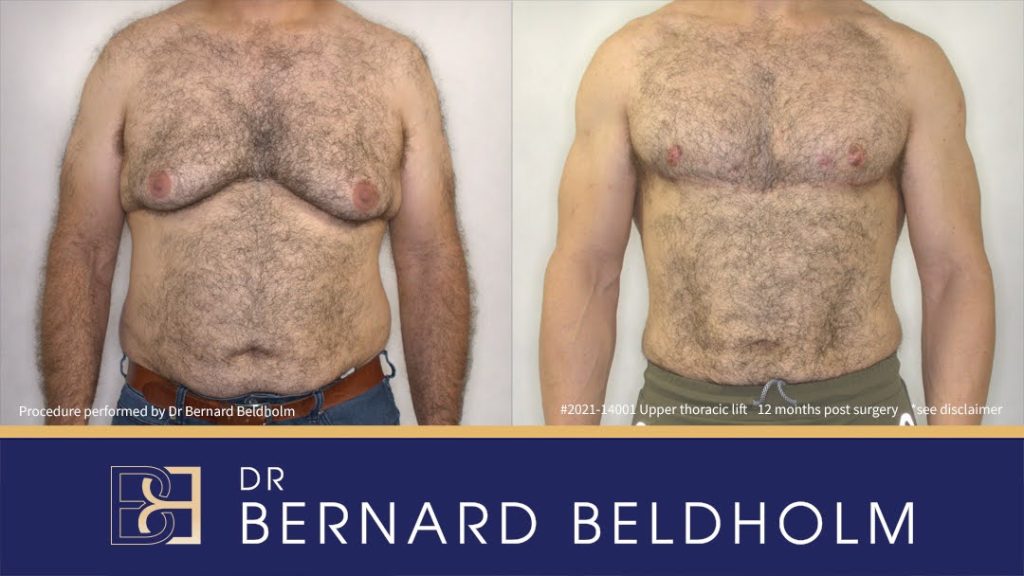
Disclaimer: Operation performed by Dr Bernard Beldholm. Adult content, surgery has risks; individual results vary, seek 2nd opinion. Please see the full disclaimer.
For patients with real or pseudo-gynaecomastia with ptosis and NAC sitting more than 2 cm below the IMF, Torsoplasty (upper thoracic lift) with free NAC, a surgical procedure that involves removing excess breast tissue and repositioning the nipples to a more natural location on the chest, is a more extensive surgical option reserved for severe cases of gynaecomastia.
Why Grading Systems Were Created
The purpose of creating the grading systems has been to provide a standardised way of assessing the severity of the condition, guiding treatment decisions, and predicting outcomes.
By categorising the condition into grades based on factors such as breast size, skin excess, and degree of ptosis, healthcare providers could tailor treatment approaches more effectively, by facilitating more effective communication among specialists, and ensuring patients received consistent care.
Over the years, several grading systems for gynaecomastia have been developed. Surgeons have relied upon them when determining the best surgical approach for treating the condition, ranging from less invasive procedures such as liposuction (Suction-assisted lipectomy) for lower grades to surgery for more complex cases.
Why Some Earlier Grading Systems Are No Longer Useful
- Many of the grading systems are old, outdated, and absent of detail.
- Treatments have changed
- Patients have changed.
- More weight loss surgery patients are experiencing loose skin after massive weight loss
- Obesity epidemic is causing more pseudo-gynaecomastia cases than ever
- Changes in body acceptance and aesthetic goals
- Results based on these systems are not successful based on today’s standards.
Book your appointment online now
Dr Beldholm Opinions on Earlier Classification Systems
Nydick 1961
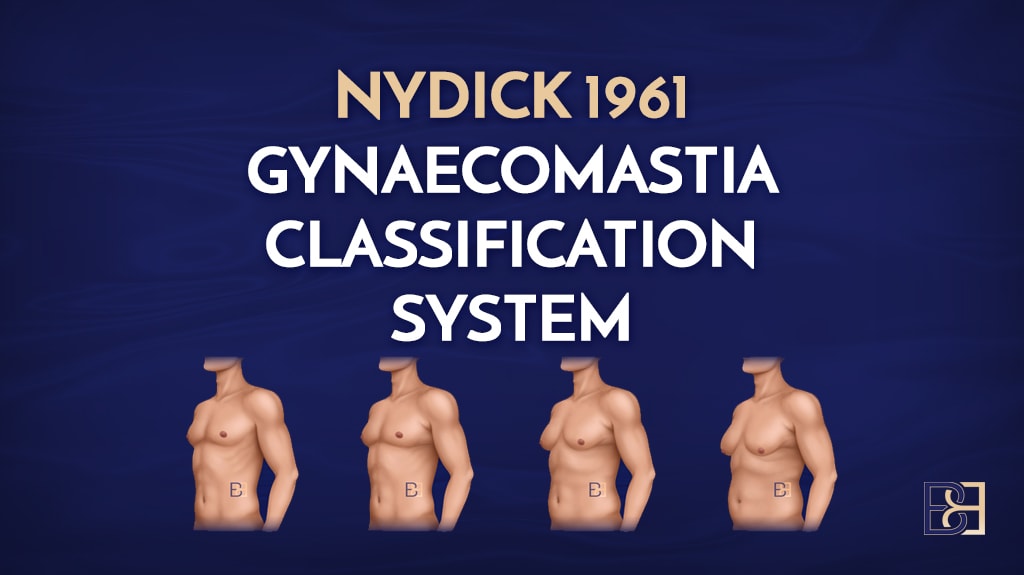
From a historical perspective, I found this article to be very interesting as it tried to quantify the incidents of gynaecomastia. I found the study to be flawed in a number of ways, however.
- First, the Nydick system only explored the adolescent population in a very non-inclusive setting, as all the participants were boys from middle class homes who were away at camp with the Boy Scout organisation.
- This is a very old study which makes it too primitive for modern applications, though it was very interesting.
- The grading system for gynaecomastia is not useful for modern surgery or male gynaecomastia patients that I see in my clinic.
- Grade 1-2 are basically small gynaecomastia that is treated with subcutaneous mastectomy.
- Grade 3 basically groups together all of the other levels of severity and presentations, thus, not very helpful in modern practice.
Simon 1973
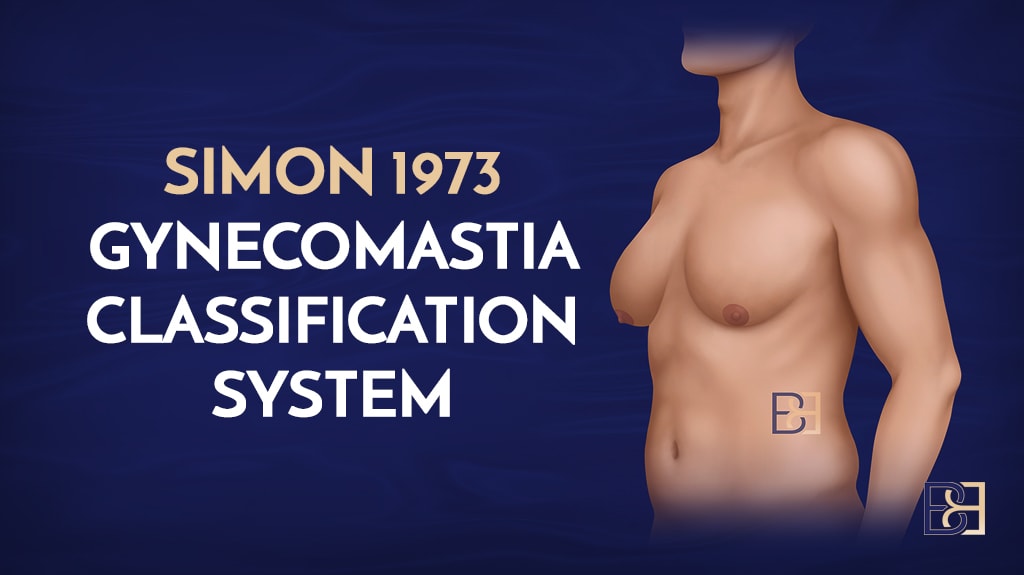
- Outdated: The Simon system has not been updated to incorporate modern diagnostic tools, such as Suction-assisted lipectomy.
- Results unacceptable by modern standards: The results would not be acceptable today with a significant amount of saucer deformity.
- Subjective and ambiguous: There is ambiguity between grades, especially between IIa and IIb or IIb and III, as they are differentiated mainly by terms such as “moderate” excess skin.
- No mention of psychological impact among the grades: The system does not consider the psychosocial impact associated with the different grades of gynaecomastia which can vary widely even with similar levels of severity.
Cohen 1987
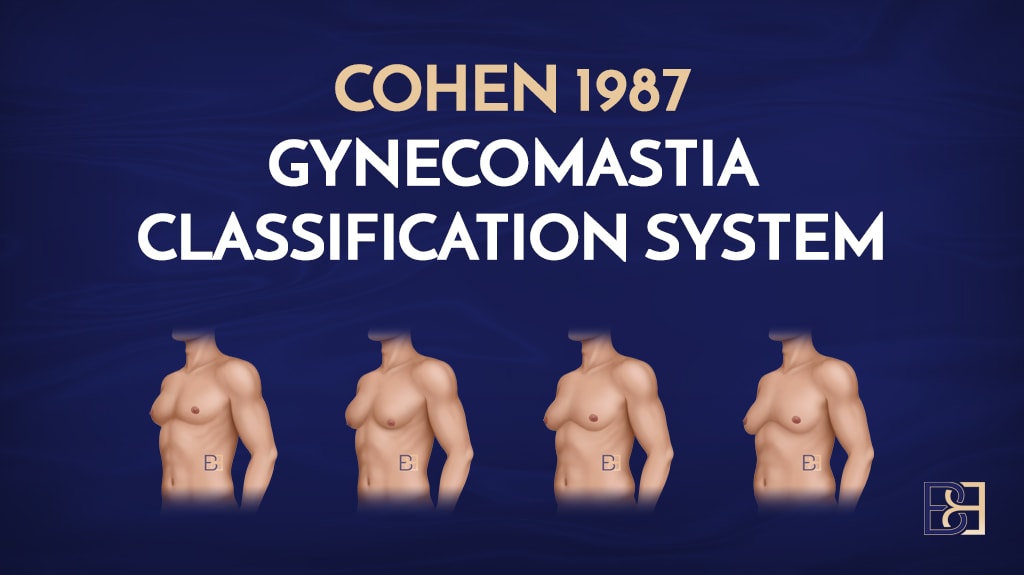
- Overly simplistic: While the Cohen classification provides a helpful baseline, it lacks the depth and adaptability of newer systems that offer more precise categorisation and guidance for current treatment options.
- Subjective: As there is no definition of what “predominantly glandular” means, the article is very subjective, which may be why Rosenberg developed his own take on a less invasive treatment for gynaecomastia.
- Vague: There is also no obvious definition of what “ptotic” means.
- No severity grading: There is no gradation of the severity of gynaecomastia.
- Antiquated: This grading system is quite old and not very useful in current applications.
Rohrich 2003

Advantages of Rohrich System:
- Provides a structured approach to categorising gynaecomastia based on severity and tissue characteristics (glandular/adipose tissue, skin elasticity, and areolar positioning).
- Enables more precise surgical planning, optimising aesthetic outcomes
- Helps in tailoring treatment strategies for individual patient needs.
- Minimizes trauma to surrounding tissues, leading to fat removal.
Disadvantages of Rohrich System:
- Main Issues:
- Grading gynaecomastia based primarily on glandular vs. fibrous tissue may not be the most accurate or helpful method.
- The system does not account for the degree of ptosis (drooping), an important factor in surgical planning.
- It does not consider pseudo-gynaecomastia, which can have different treatment requirements.
- The system suggests Ultrasound-assisted liposuction as the primary treatment, with potential staged gland excision, which, according to Dr. Beldholm, may significantly undertreat a large portion of patients who need more extensive intervention.
- Grading System Concerns:
- Estimating the grams of gynaecomastia without detailed imaging (e.g., ultrasound) could lead to inaccurate assessments for treatment.
- Overall, Dr. Beldholm finds the Rochrich grading system to lack comprehensive usefulness for effective clinical decision-making.
Ratnam 2009
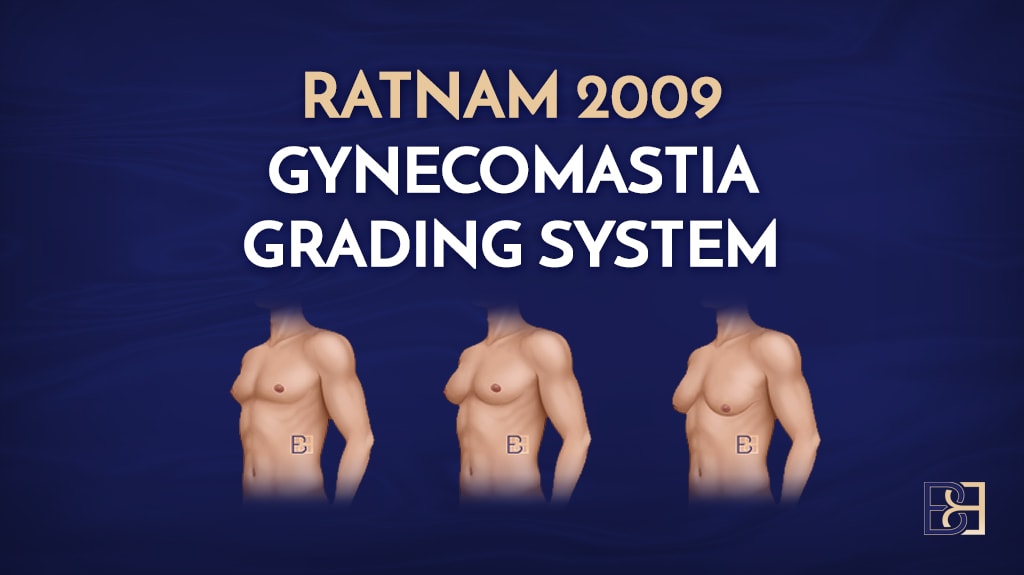
- The Ratnam Grading system is too simple.
- The treatments that they offered for skin reduction was circular reduction of the areola with no other radical excision offered. Gynaecomastia patients with ptotic breasts and loose skin are likely to not be adequately treated with a circular excision of skin.
- There is no mention of small gynaecomastia that can be treated by excision only.
- The classification of an IMF fold as being abnormal in a male I find anatomically incorrect. In a normal male without defined muscles there may not be a fold. However in a muscular male there is a fold. Trying to remove the fold will make these men look worse
- There is not enough of a sample to be able to conclude what the authors concluded
Gusenoff 2008
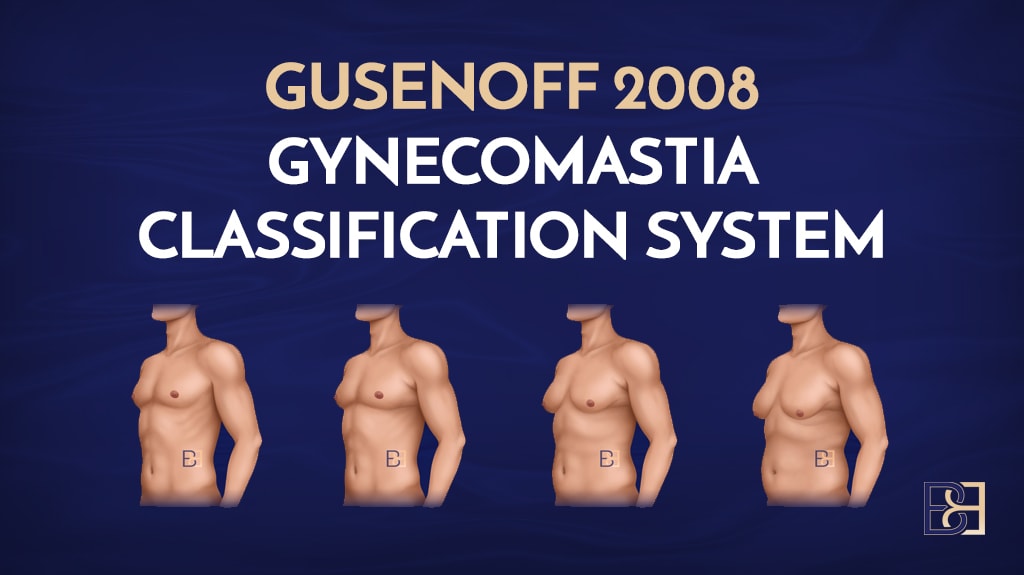
The Gusenoff 2008 Gynaecomastia Classification System is a practical and surgeon-oriented grading tool, particularly useful in evaluating and planning surgical treatments for patients with moderate to severe gynaecomastia, however, there are disadvantages to this system.
Its utility is limited in non-surgical management or milder cases of gynaecomastia.
- Most male post weight loss patients that have excess skin and are unhappy with their chest need excision of skin and free grafts.
- In my experience, post-weight loss patients have limited benefit from smaller treatments such as liposuction as their skin is generally inelastic and will not pull back to its new shape. This will vary from patient to patient, but it is true for most massive weight loss patients.
- The study was not comprehensive enough to make many conclusions
- In my experience, the pedicle technique leaves too much excess tissue and has a tendency to make the male chest still have a round appearance and less masculine
Cordova and Moschella 2008
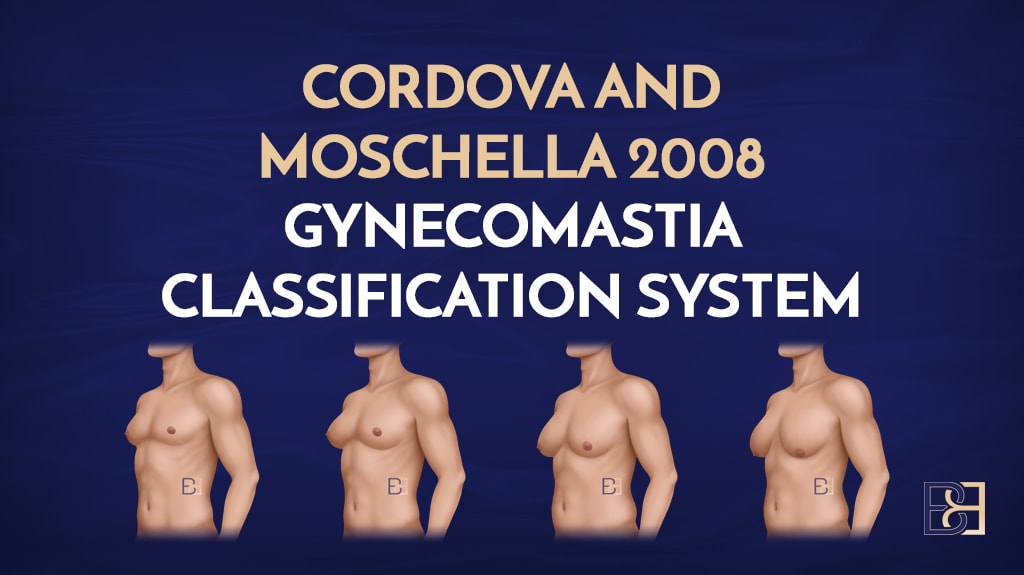
- Cordova and Moschella is a useful tool in both clinical practice and research, helping standardise treatment approaches and improving patient outcomes in the management of gynaecomastia.
- It takes the position of NAC (Nipple-areola complex) and gland excess into account.
- It is not very precise, however, as it frames the excess as “hypertrophy” and does not give a good sense of the extent of hypertrophy.
- In grade 4, I would recommend excision of the skin with NAC grafts.
Barros 2012
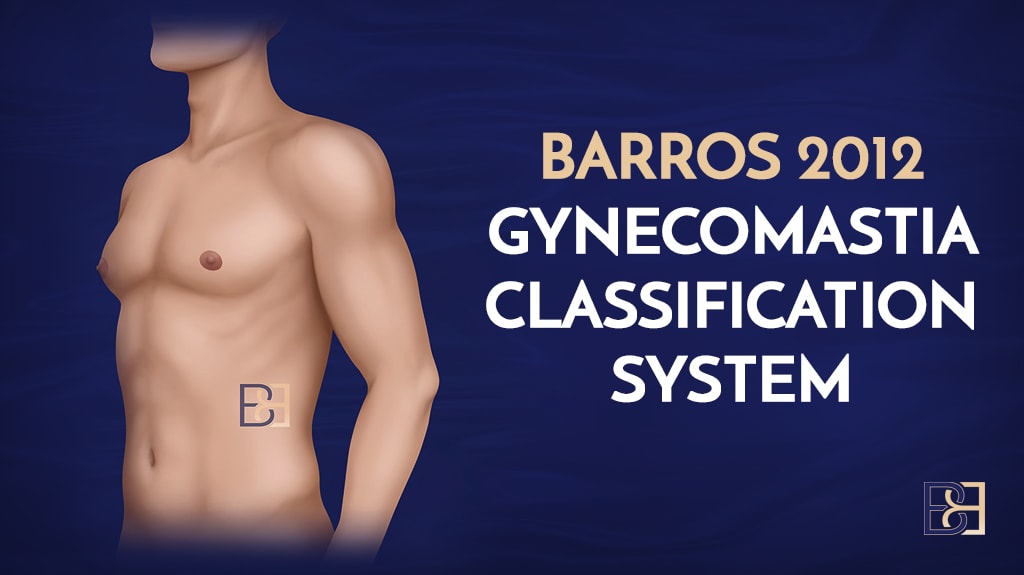
- Barros does not contain an explanation as to why this classification system was created. Where other systems, such as the Ratnam classification system were created to build upon previous systems. The proposed new classification and treatment protocol were found to help solve problems associated with surgical outcomes for all types of gynaecomastia, although the issue of residual gynaecomastia in patients undergoing UAL alone requires further study. (Ref 10), the Barros system does not appear to offer an actual reason for this new classification.
- Barros does not focus on the lateral chest skin or lateral breast rolls, which must be treated to achieve an optimal outcome.
- The article recommends weight loss as the primary option for pseudo-gynaecomastia, when in fact, the impact of pseudo-gynaecomastia can be as severe as real gynaecomastia. Once a patient presents to a surgeon for treatment, the patient should be given the attention they deserve and receive surgical interventions to alleviate this condition.
Punia & Gupta (2023)
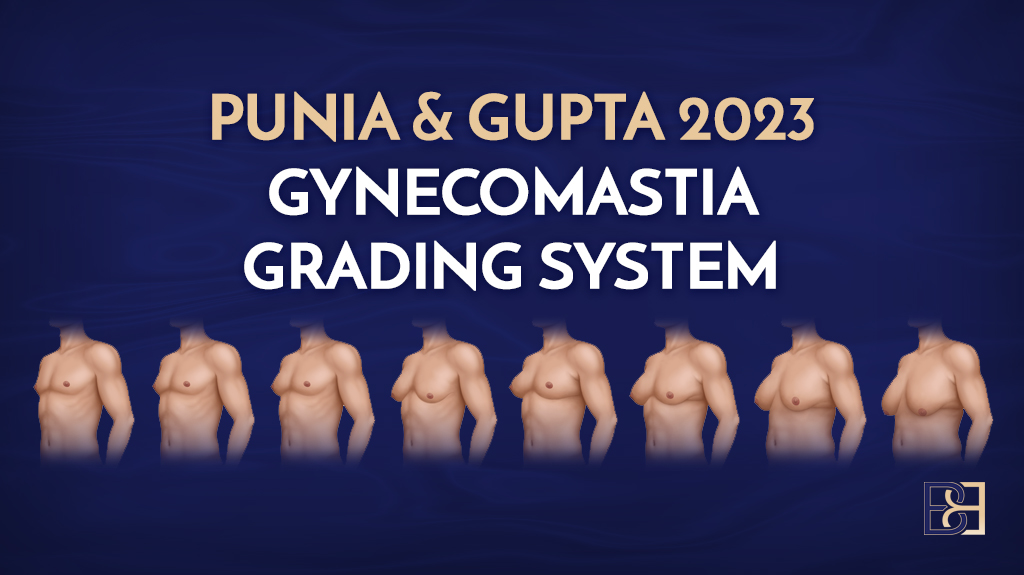
- In the Punia & Gupta system, there is no need to differentiate between 1b and 2a, as both need Suction-assisted lipectomy and gland excision.
- As to the treatment recommendations for the higher grades, grade 4 requires skin excision with nipple areolar grafts to adequately treat the excess skin.
- Though not generally considered “real Gynaecomastia,” there is no mention of pseudo-Gynaecomastia in the Punia & Gupta study, even though it can look identical and have similar consequences to real Gynaecomastia and cause significant psychological consequences for patients.
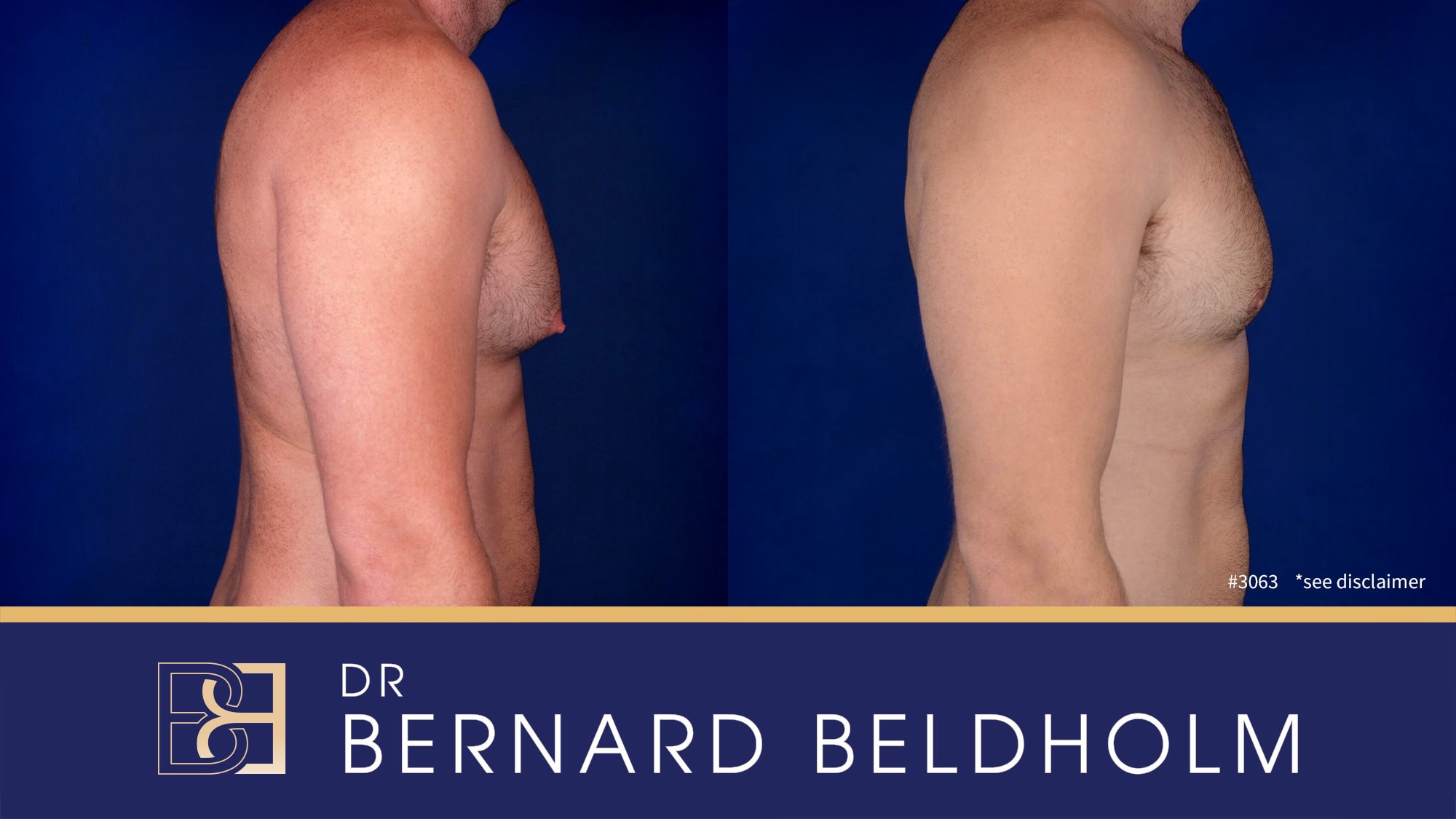
Disclaimer: Operation performed by Dr Bernard Beldholm. Adult content, surgery has risks; individual results vary, seek 2nd opinion. Please see the full disclaimer.
Book your appointment online now
For a deeper dive into grading systems for gynaecomastia, read my article, Dr. Bernard Beldholm’s Comprehensive Summary of Gynaecomastia Surgery Grading Systems.
If you’re deciding whether to undergo gynaecomastia surgery, you can find more information about the procedure, whether you’re a candidate, how to choose a specialist surgeon, and the overall process in my article, Essential Insights on Gynaecomastia Surgery for Men or watch my video which explains the procedure in great detail.
Download My Free Ebook to further explore the Gynaecomastia journey.
After performing a thorough examination in my office and asking questions about your goals, concerns, expectations, and medical history, I will tell you about the benefits, risks, downtime, cost associated with the surgery, ensuring all of your questions are answered.
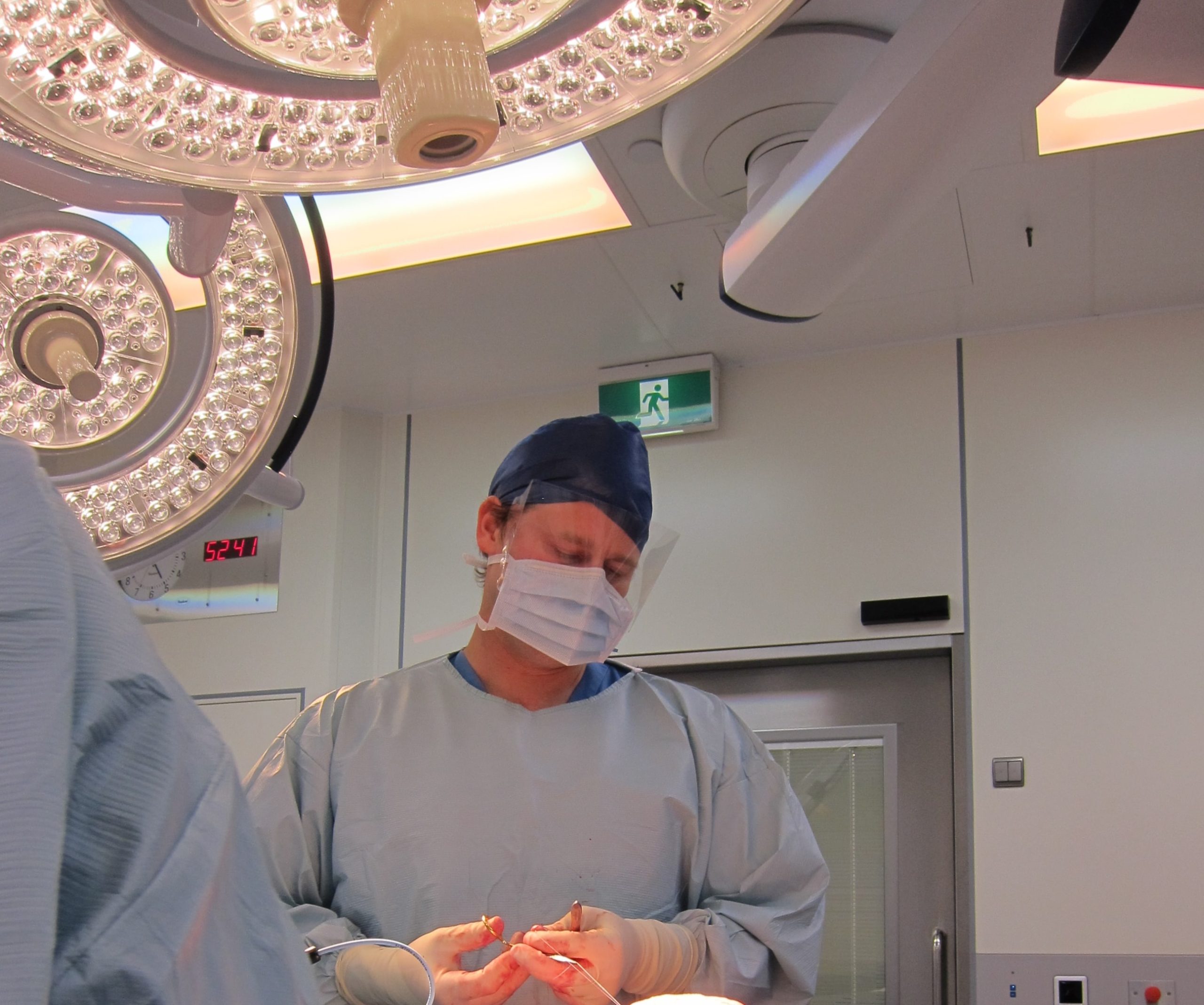
Let’s sit down and talk. Book an appointment online to learn if gynaecomastia surgery is right for you.
Resources
- Webster, G. .V Gynecomastia in the Navy. The Military Surgeon November 1944.
- Carlson, H. E. Gynecomastia. N. Engl. .J Med. 303: 795, 1980.
- Nuttall, F. Q. Gynecomastia as a physical finding in normal men. .J Clin. Endocrinol. Metab. 48: 338, 1979.
- Williams, M. .J Gynecomastia: Its incidence, recognition and host characterization in 47 autopsy cases. Am. .J Med. 34: 103, 1963.
- Nydick, M,. Bustos, ,.J Dale, J. H,. and Rawson, R. W. Gynecomastia in adolescent boys. J.A.M.A. 178: 449, 1961.
- Cohen, .I K,. Pozez, .A,L. and McKeown, .J E. Gyneco- mastia. In E. H. Courtiss (Ed.), Mael Aesthetic Surgery. St. Louis: Mosby, 1991.
- Neuman, .J .F Evaluation and treatment of gynecom- astia. Am. Fam. Physician 5: 1835, 1997.
- Teimourian, B,. and Pearlman, R. Surgery for gyneco- mastia. Aesthetic Plast. Surg. 7: 155, 1983.
- Courtiss, .E H. Gynecomastia: Analysis of 159 patients and current recommendations for treatment. Plast. Reconstr. Surg. 79: 740, 1987.
- Rosenberg, G. .J Gynecomastia: Suction lipectomy as a contemporary solution. Plast. Reconstr. Surg: 80: 379, 1987.
- Rohrich, R. ,.J Beran, S. ,.J and Kenkel, .J M. Ultrasound- Asisted Liposuction. S.t Louis: Quality Medical Publish- ing, 1998,
- LaFranchi, .S H,. Parlow, .A ,F. Lippe, B. M., Coyotupa, ,.J and Kaplan, S. .A Pubertal gynecomastia and transient elevation of serum estradiol level. Am. .J Dis. Child 129: 927, 1975.


